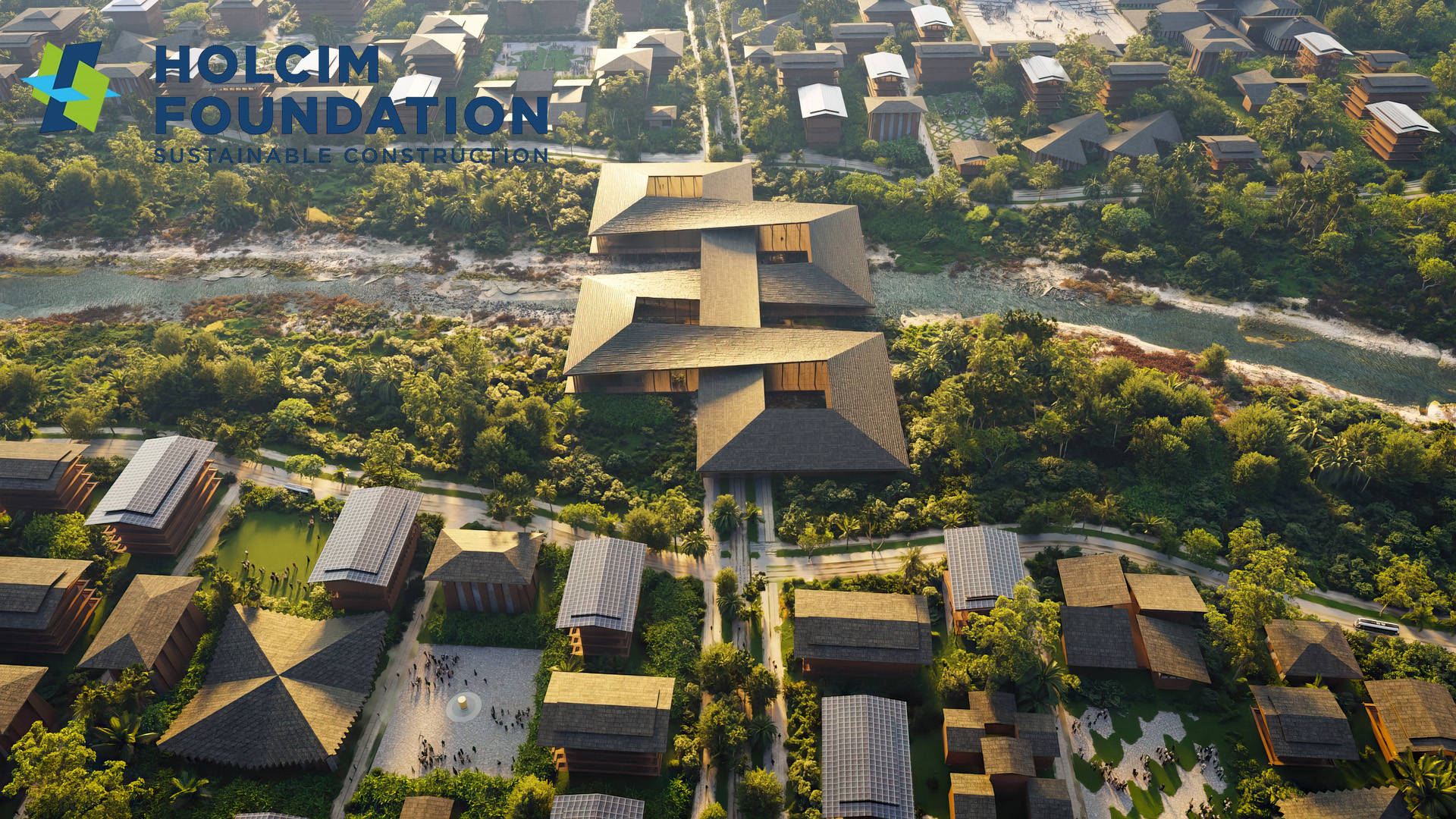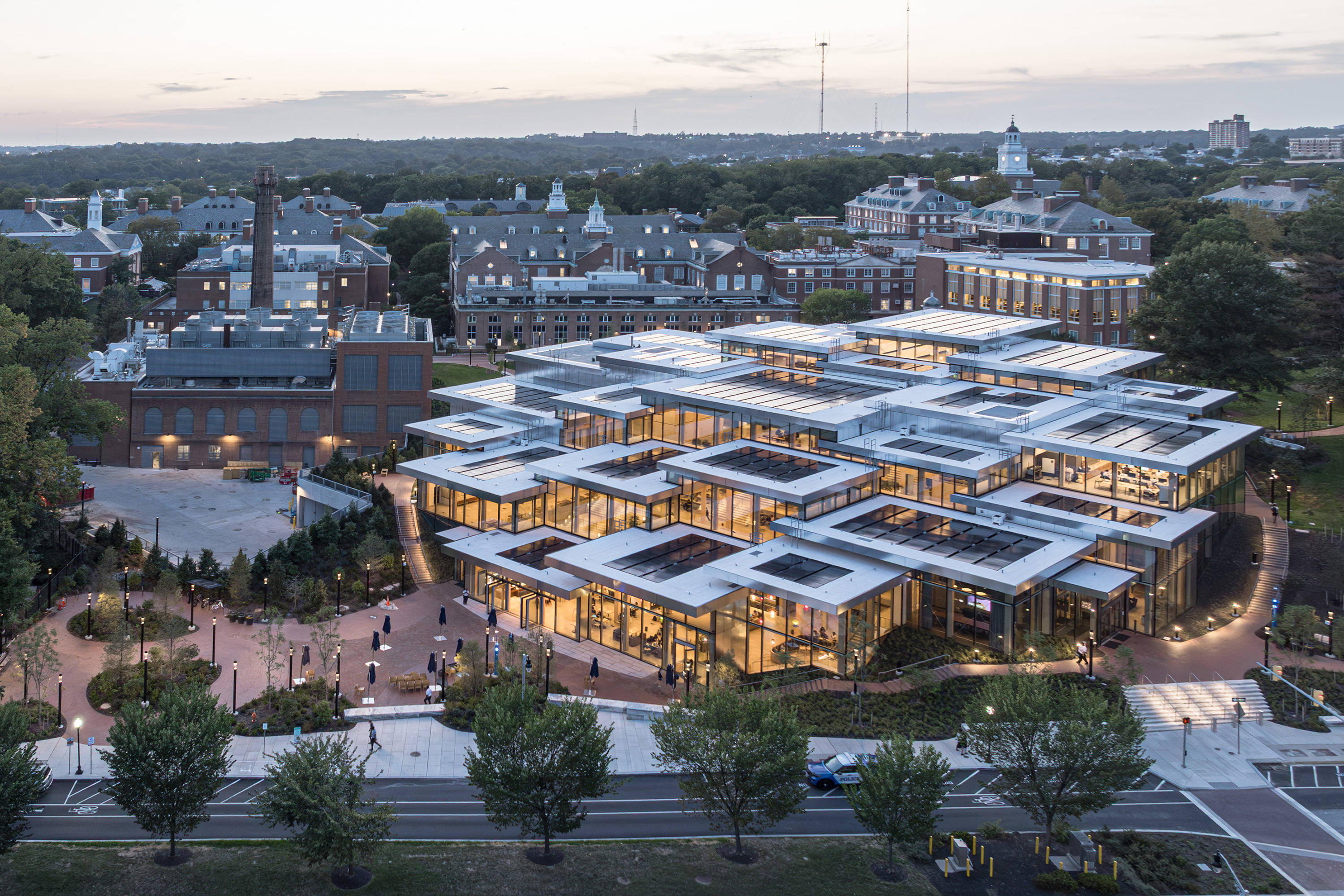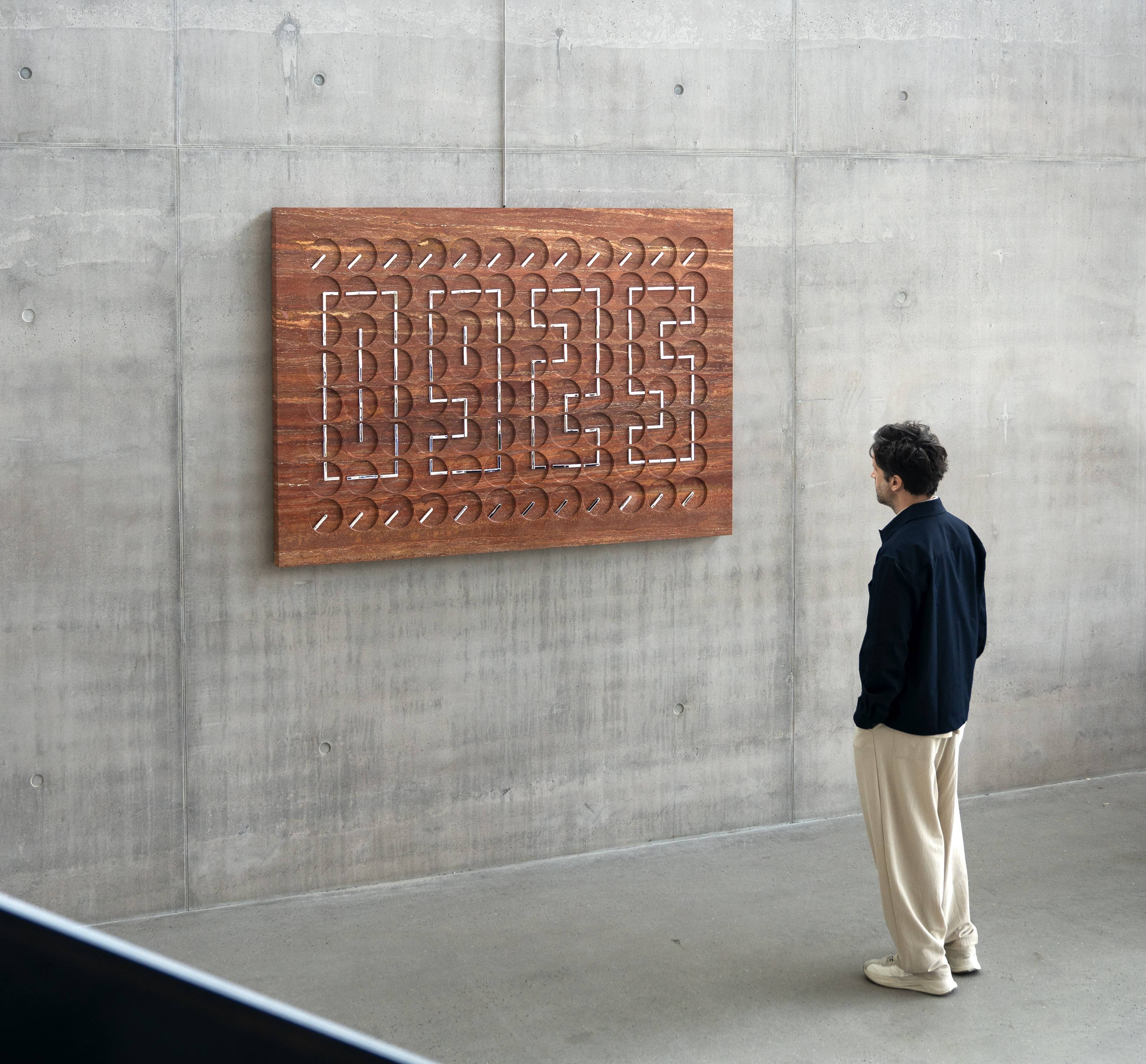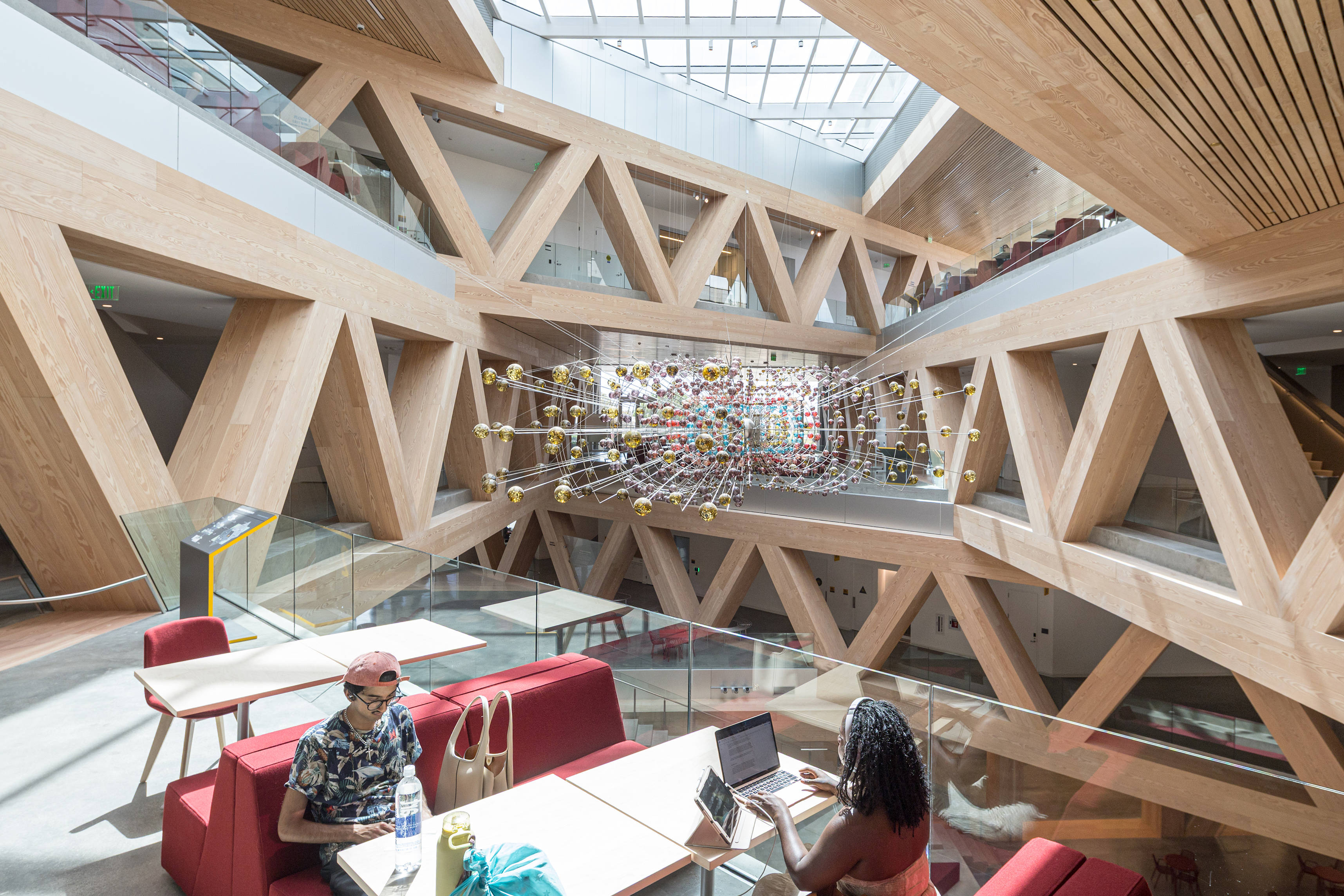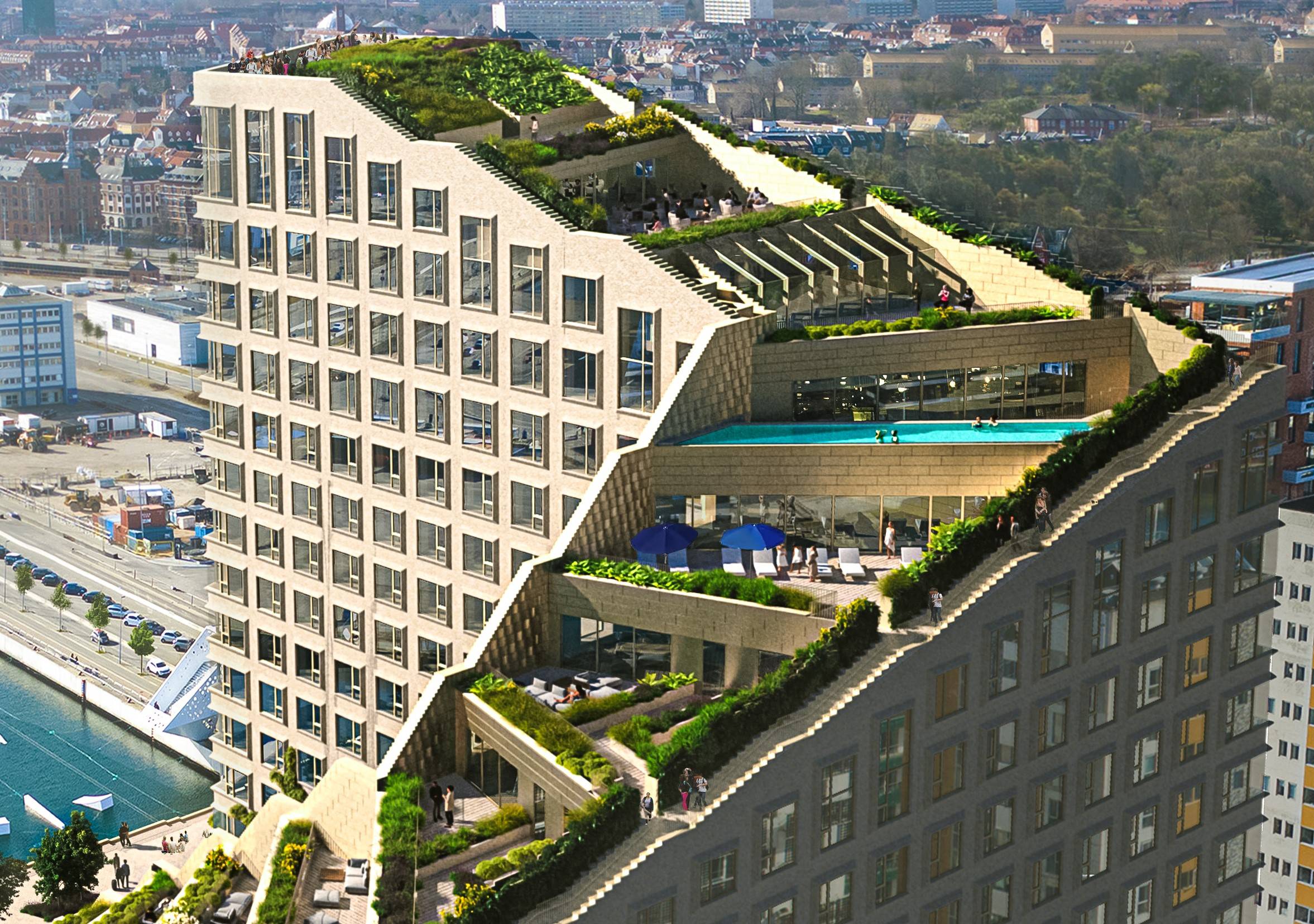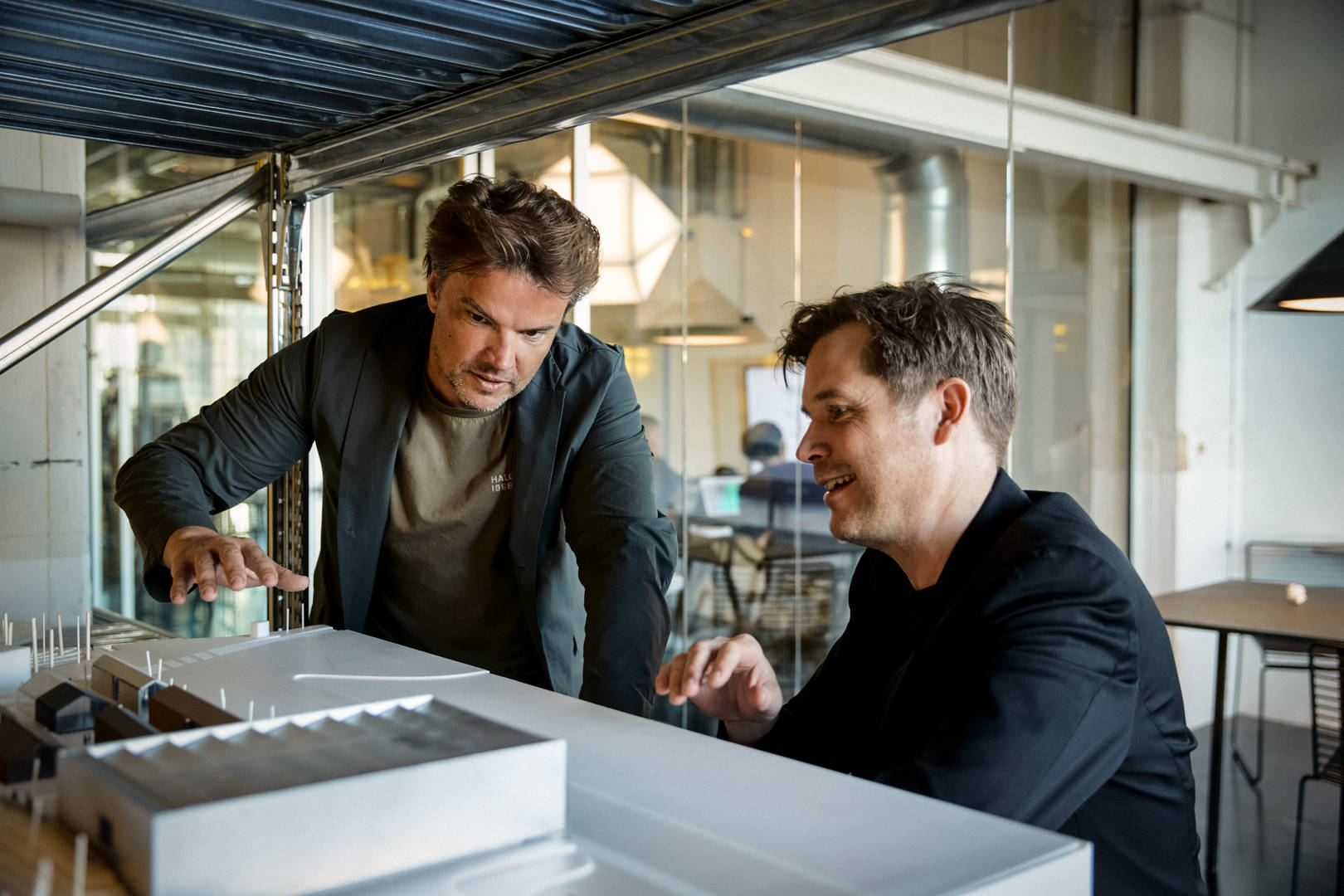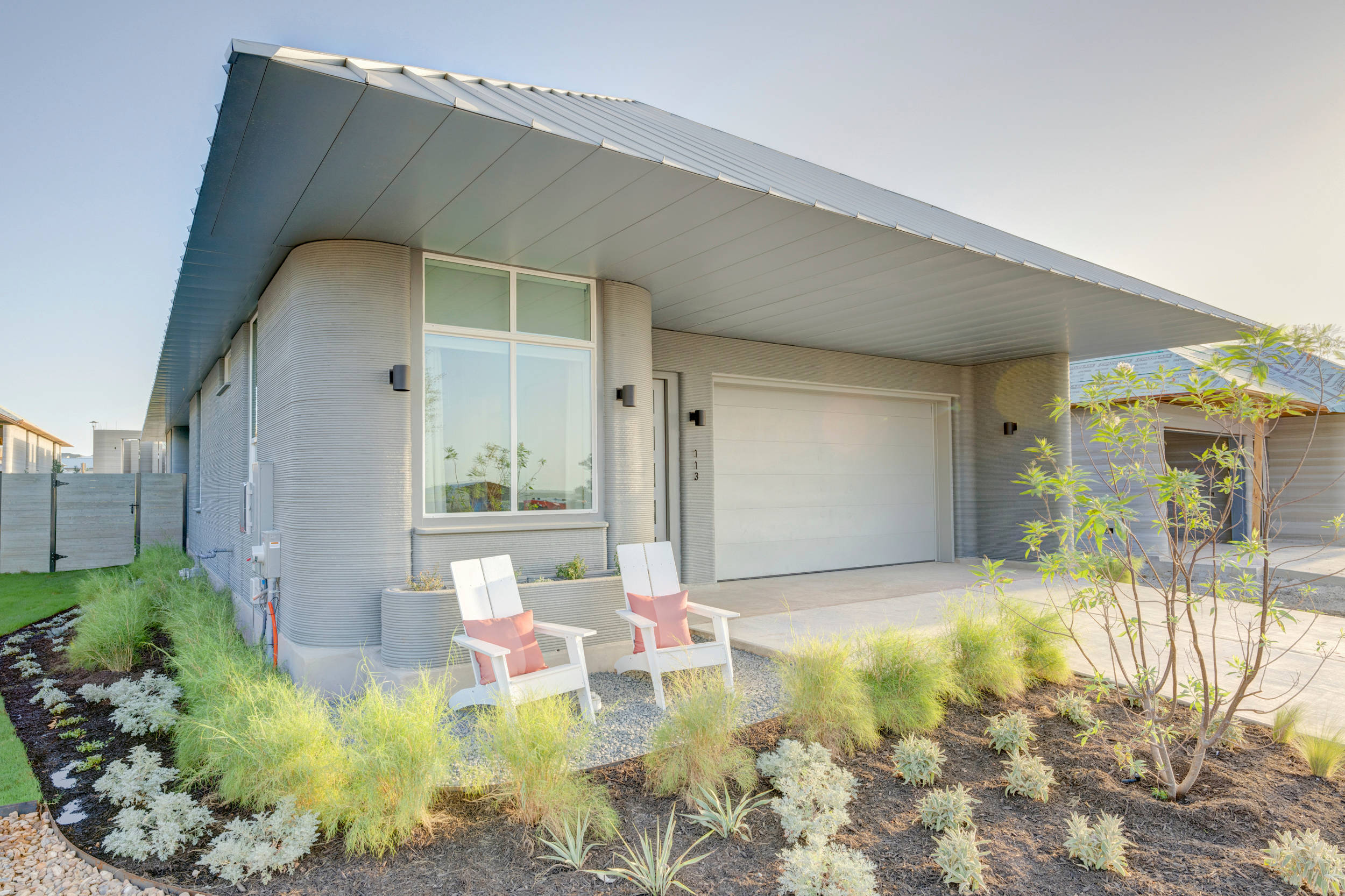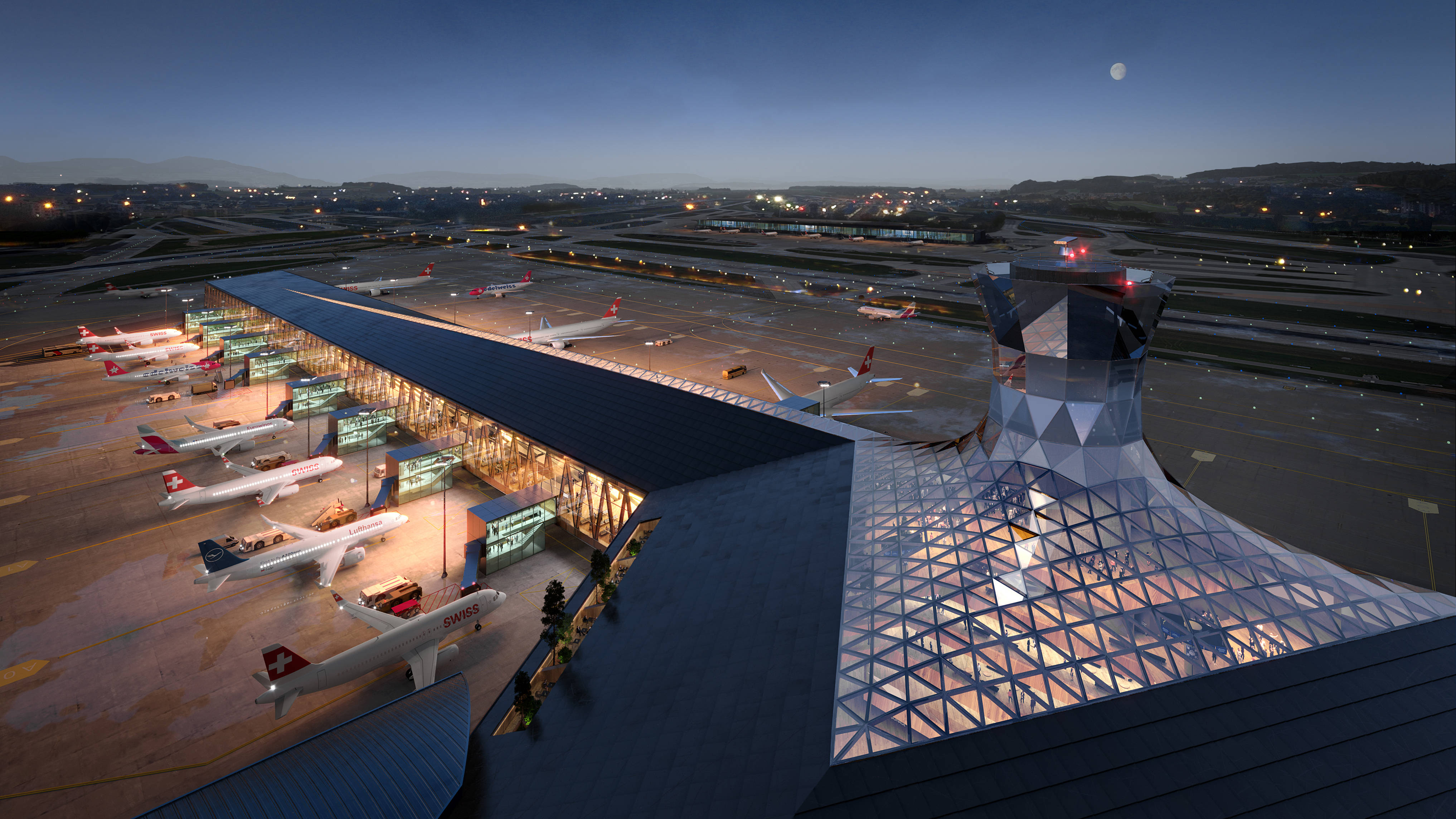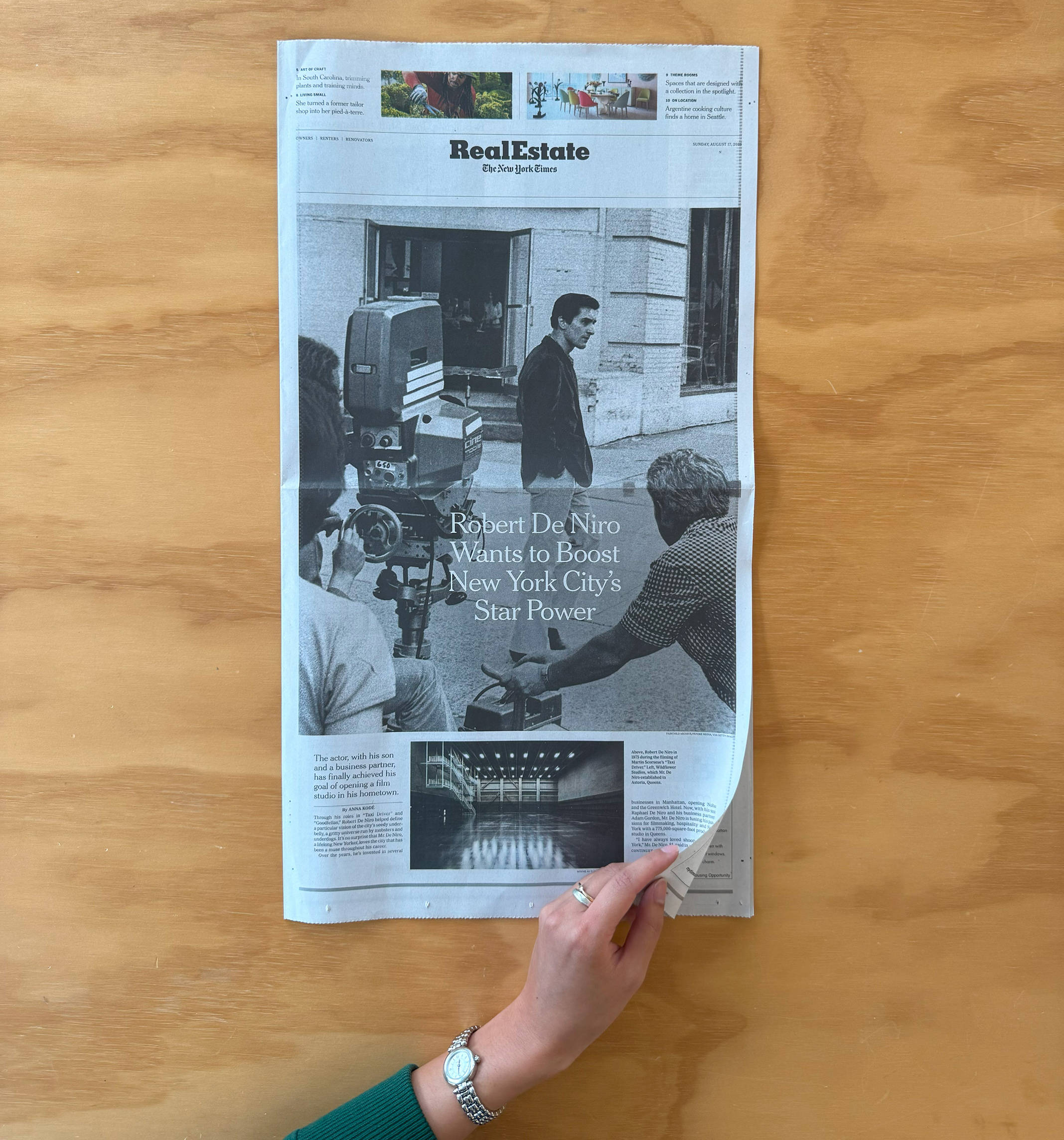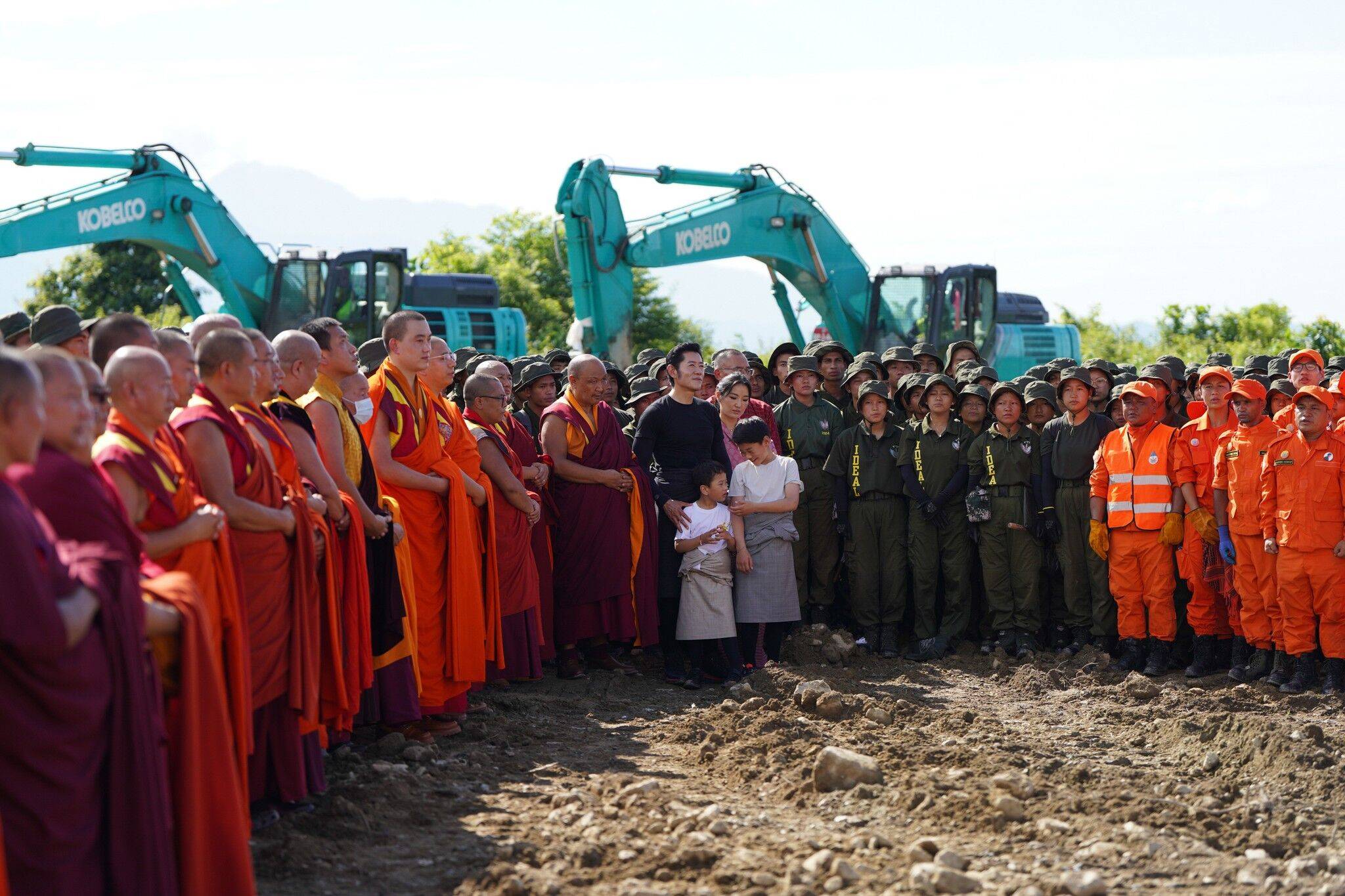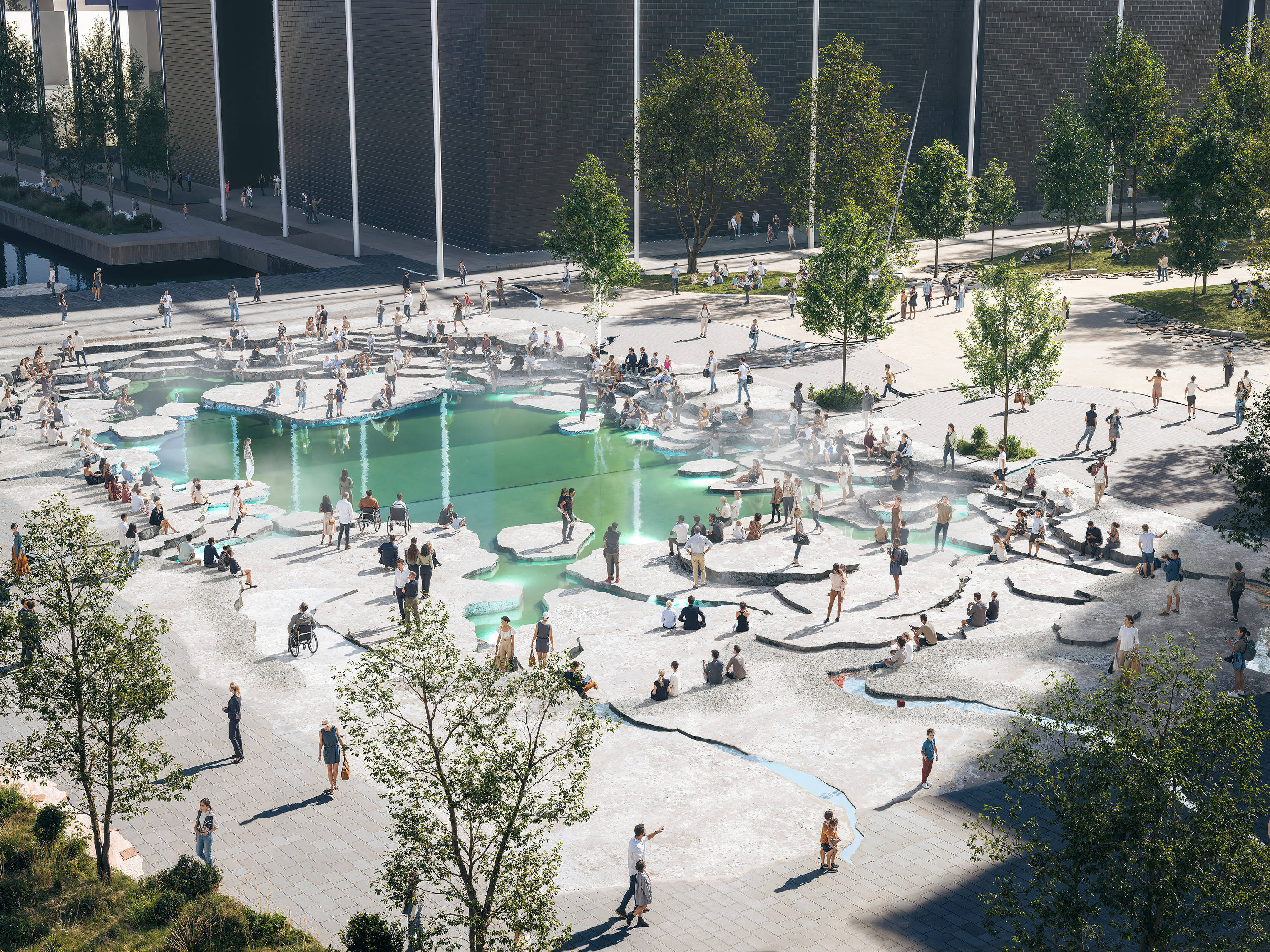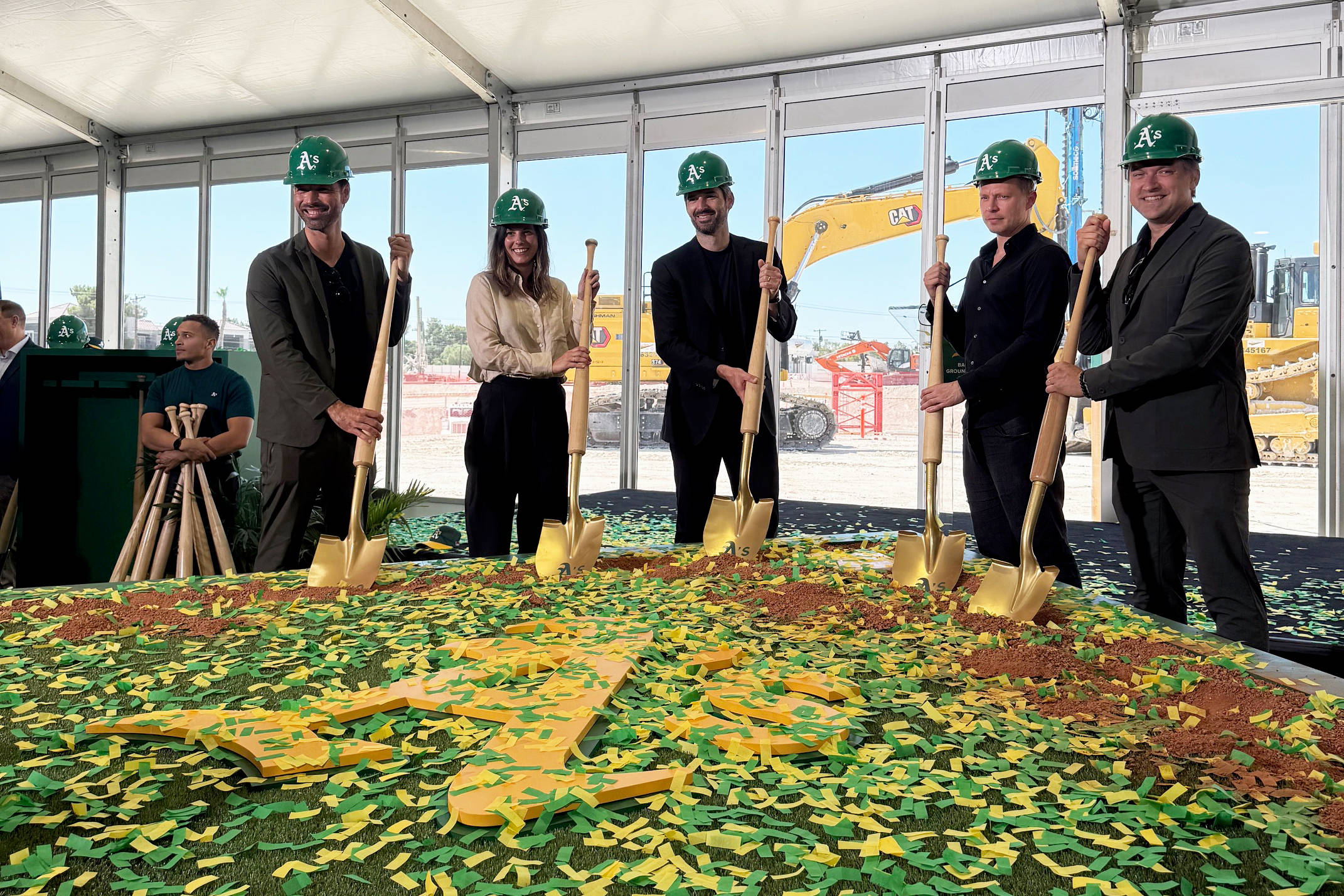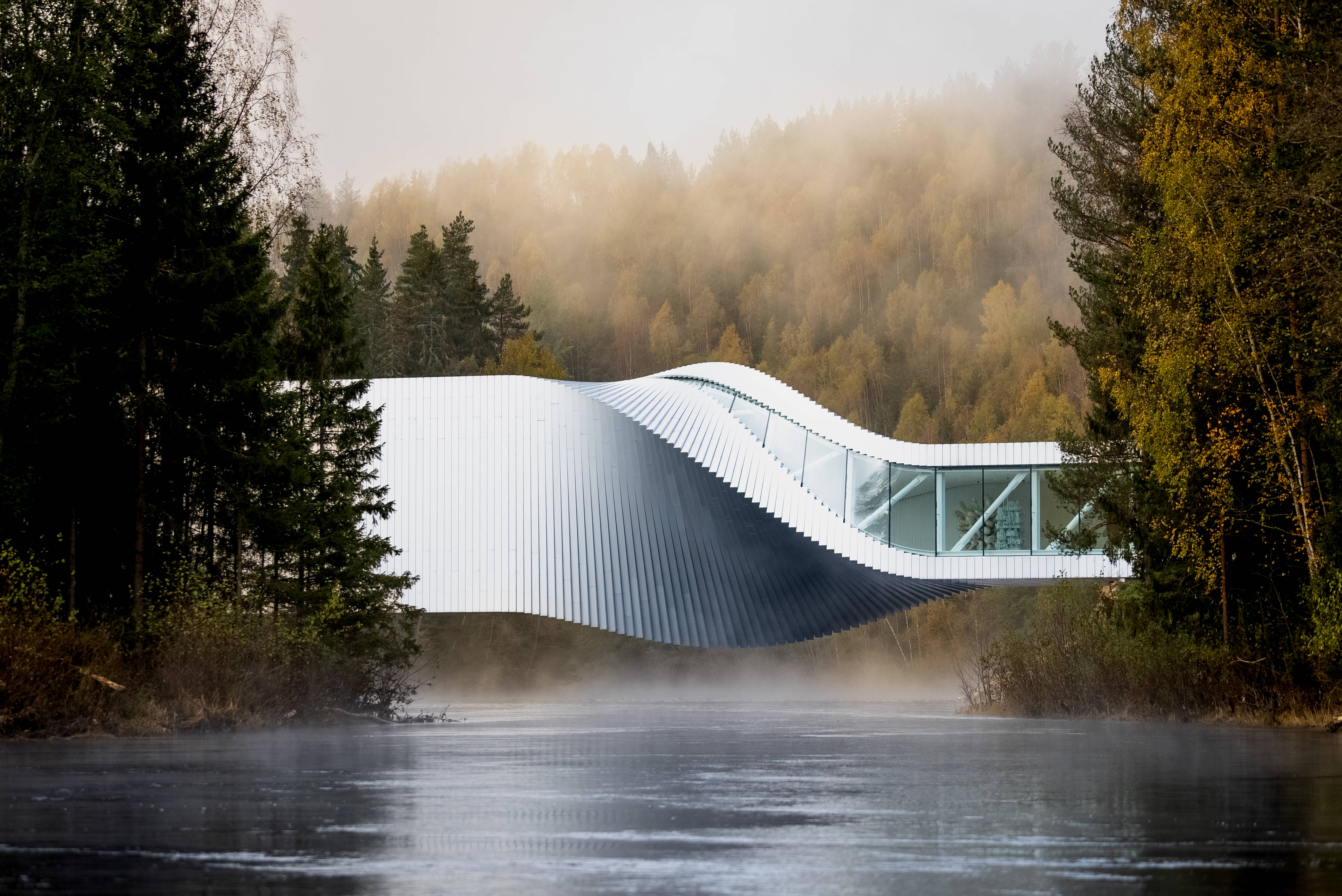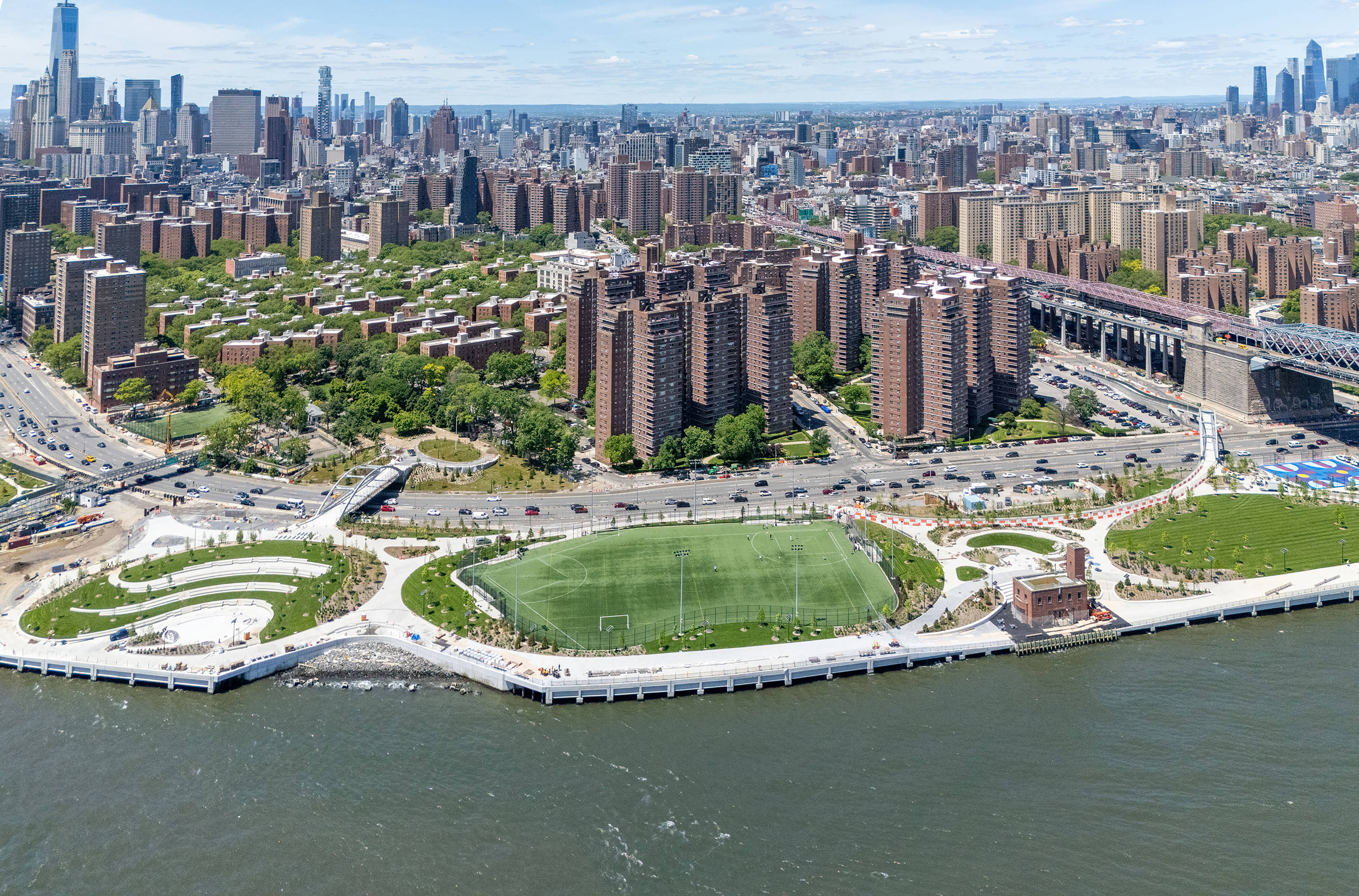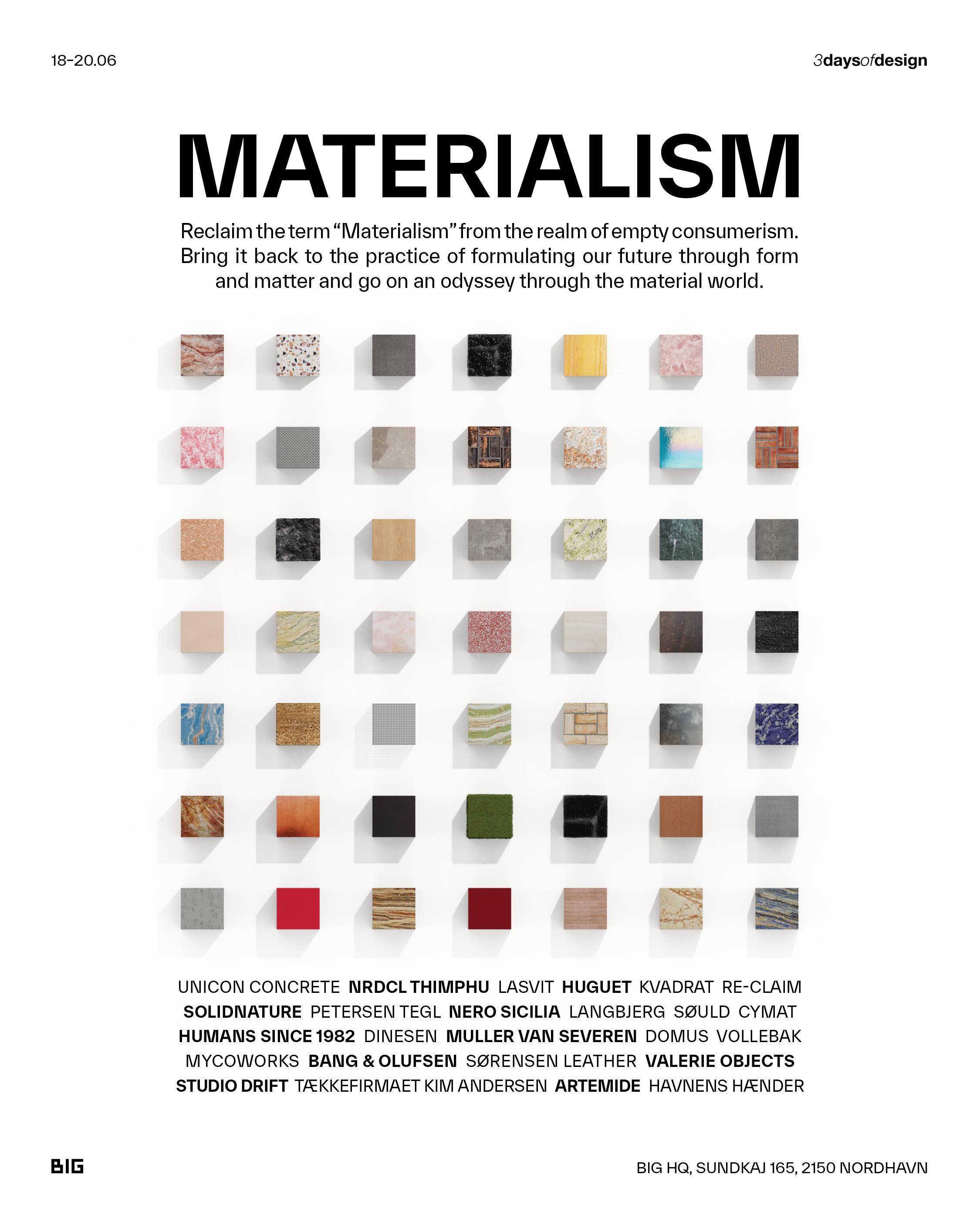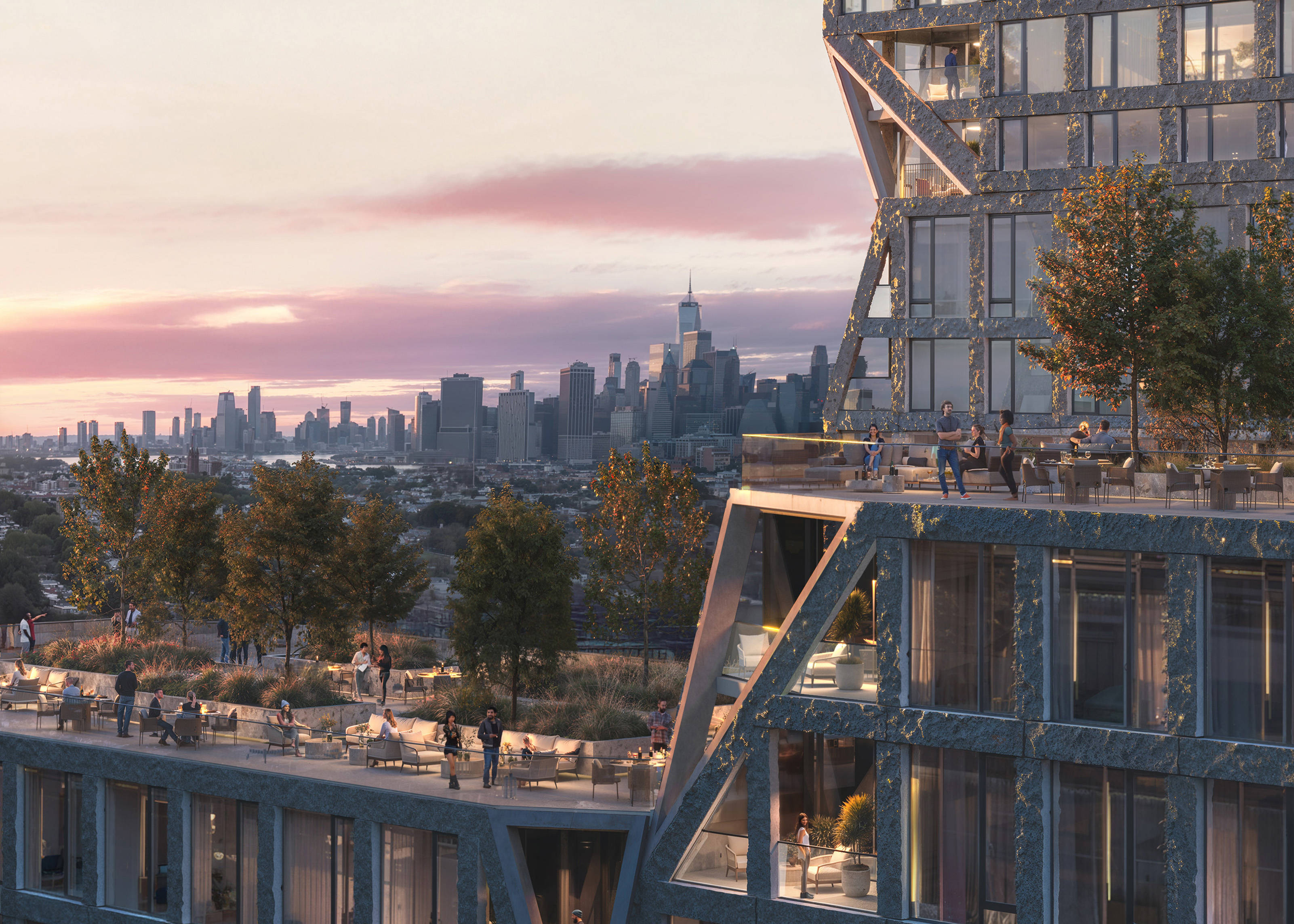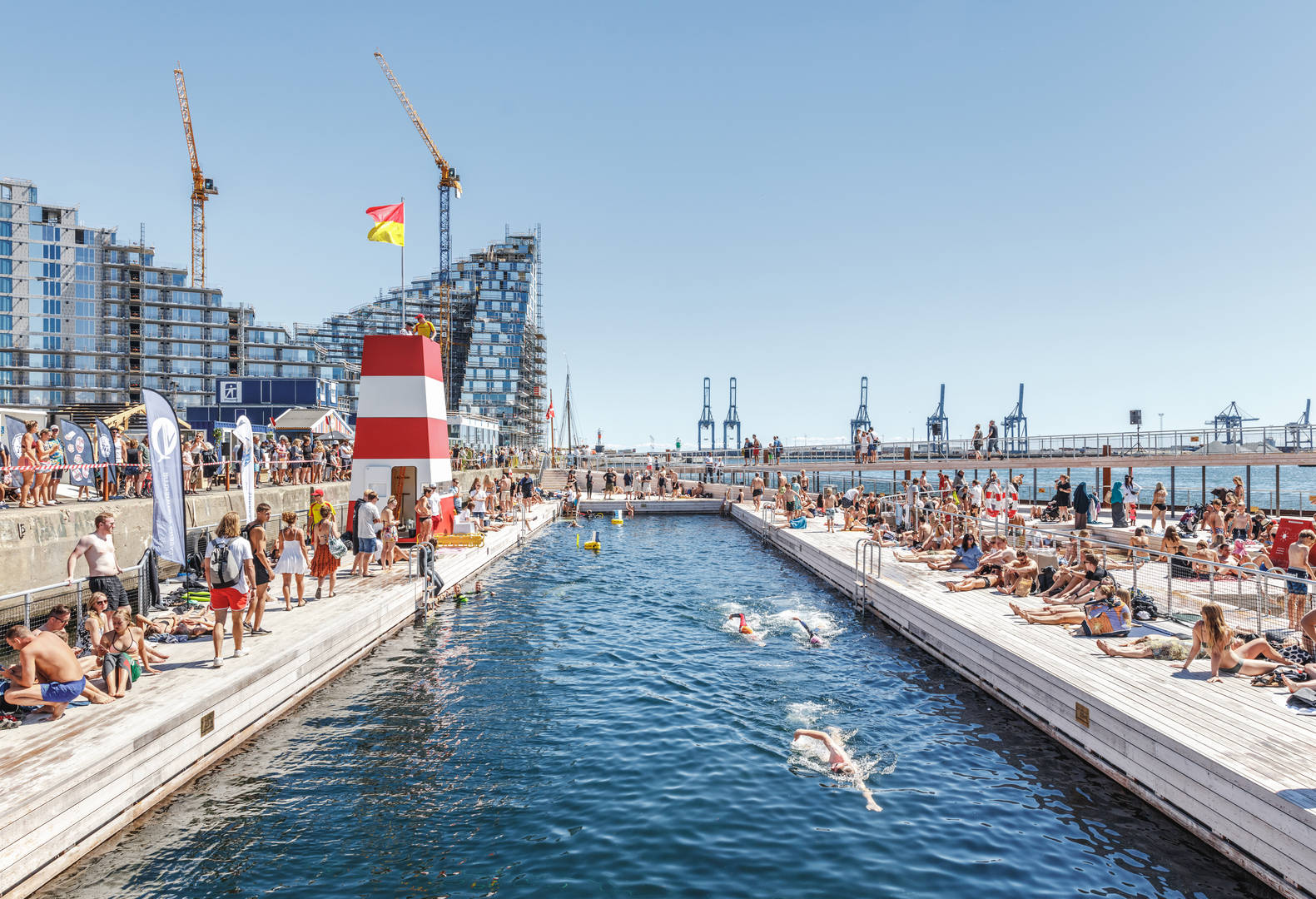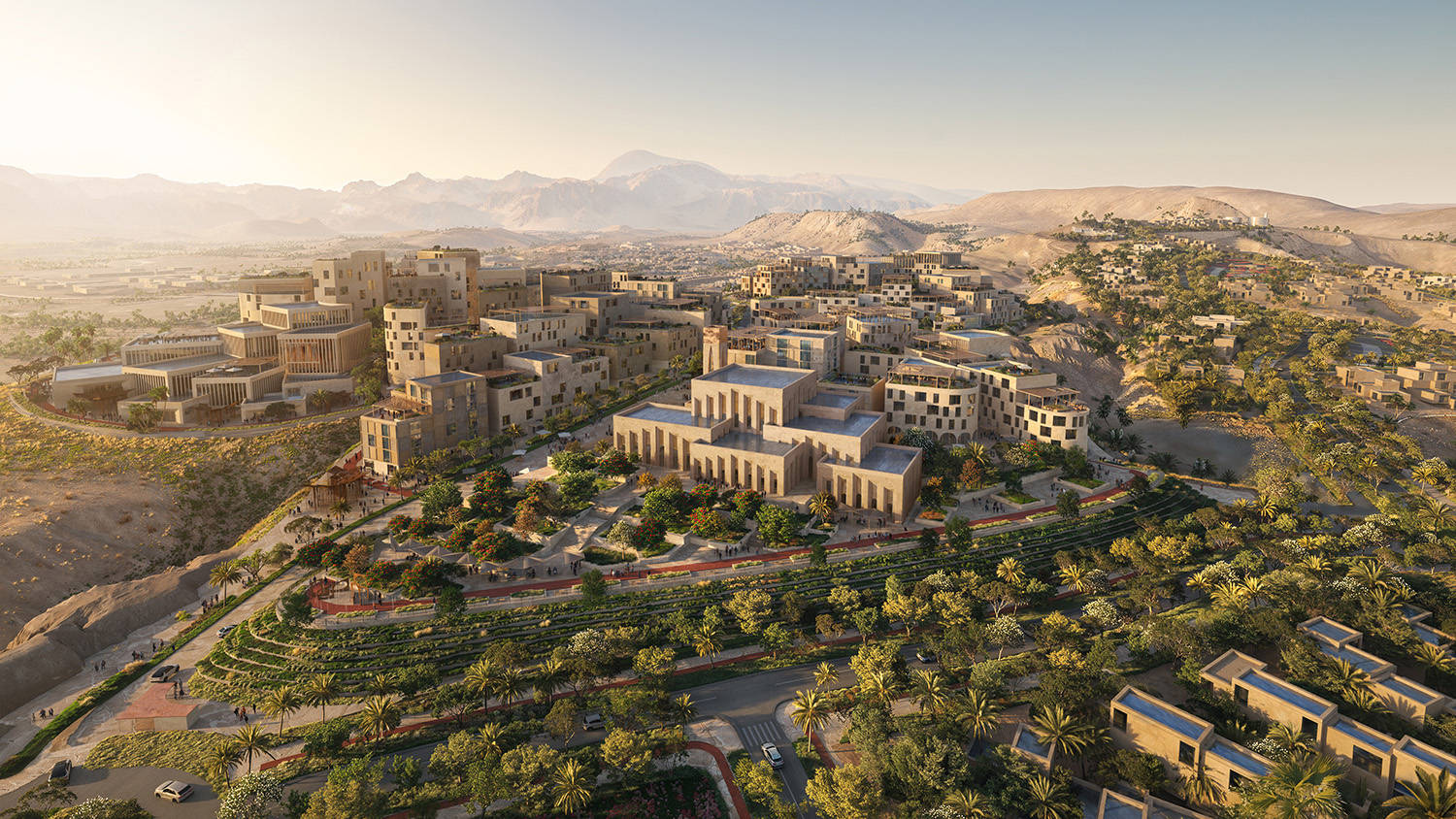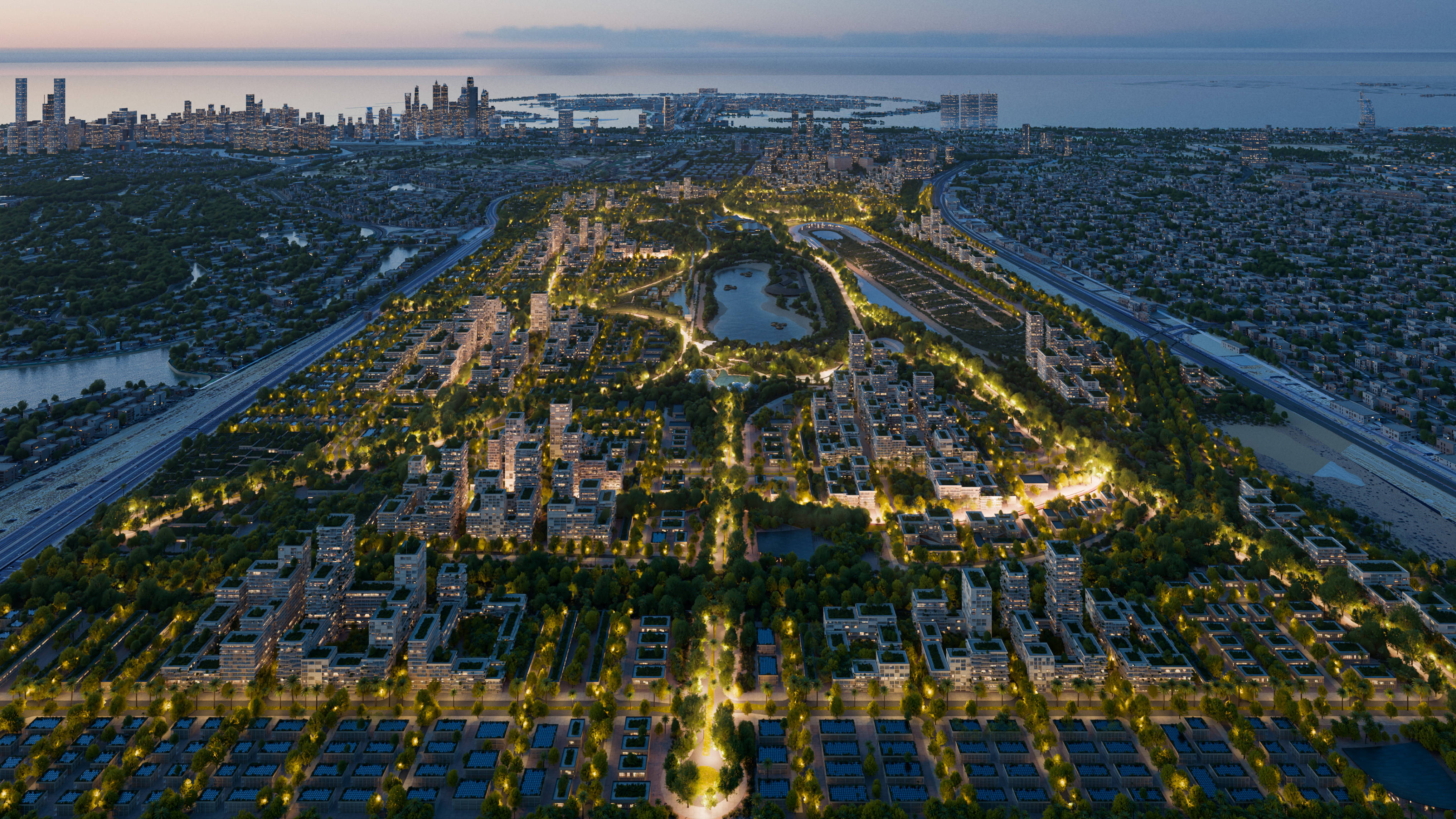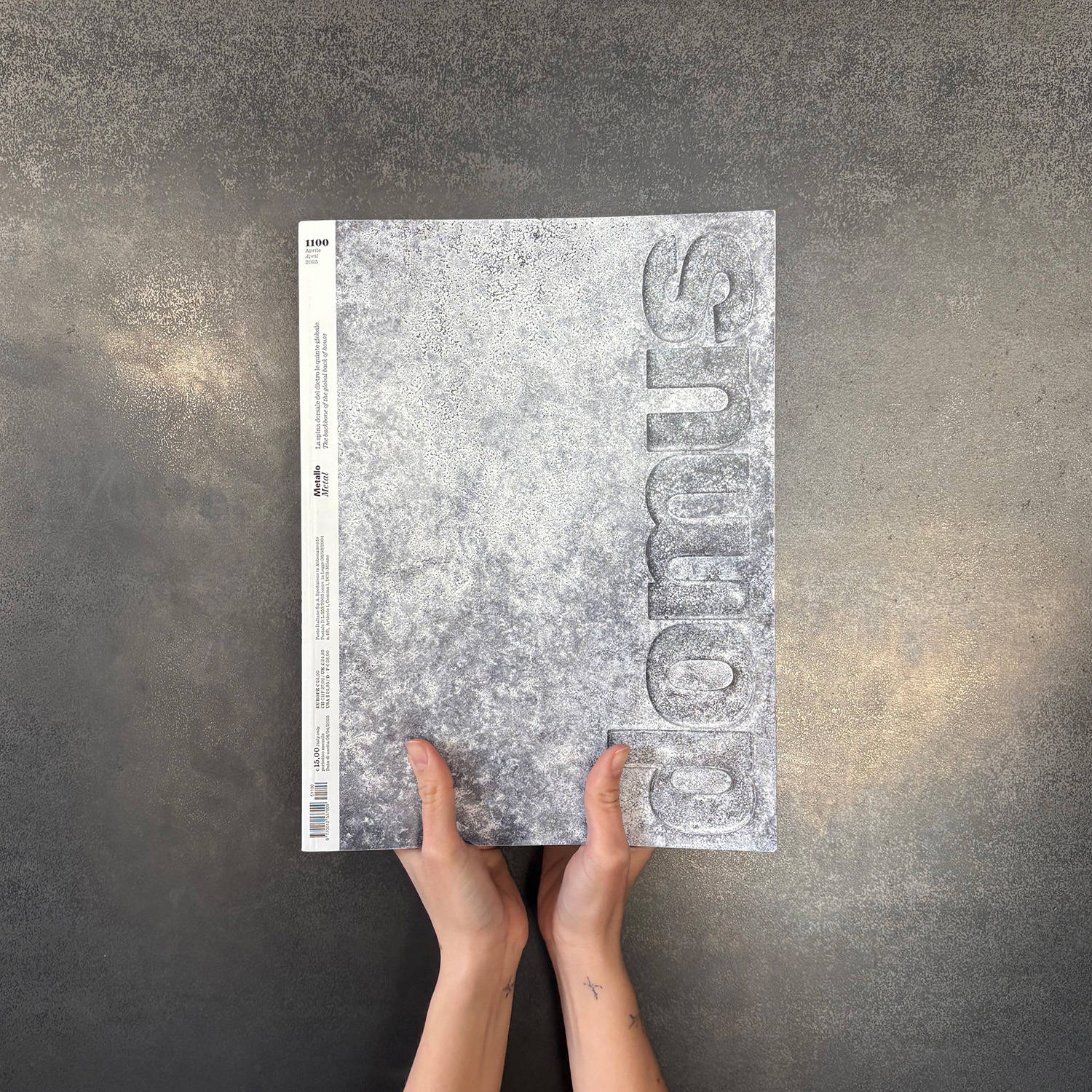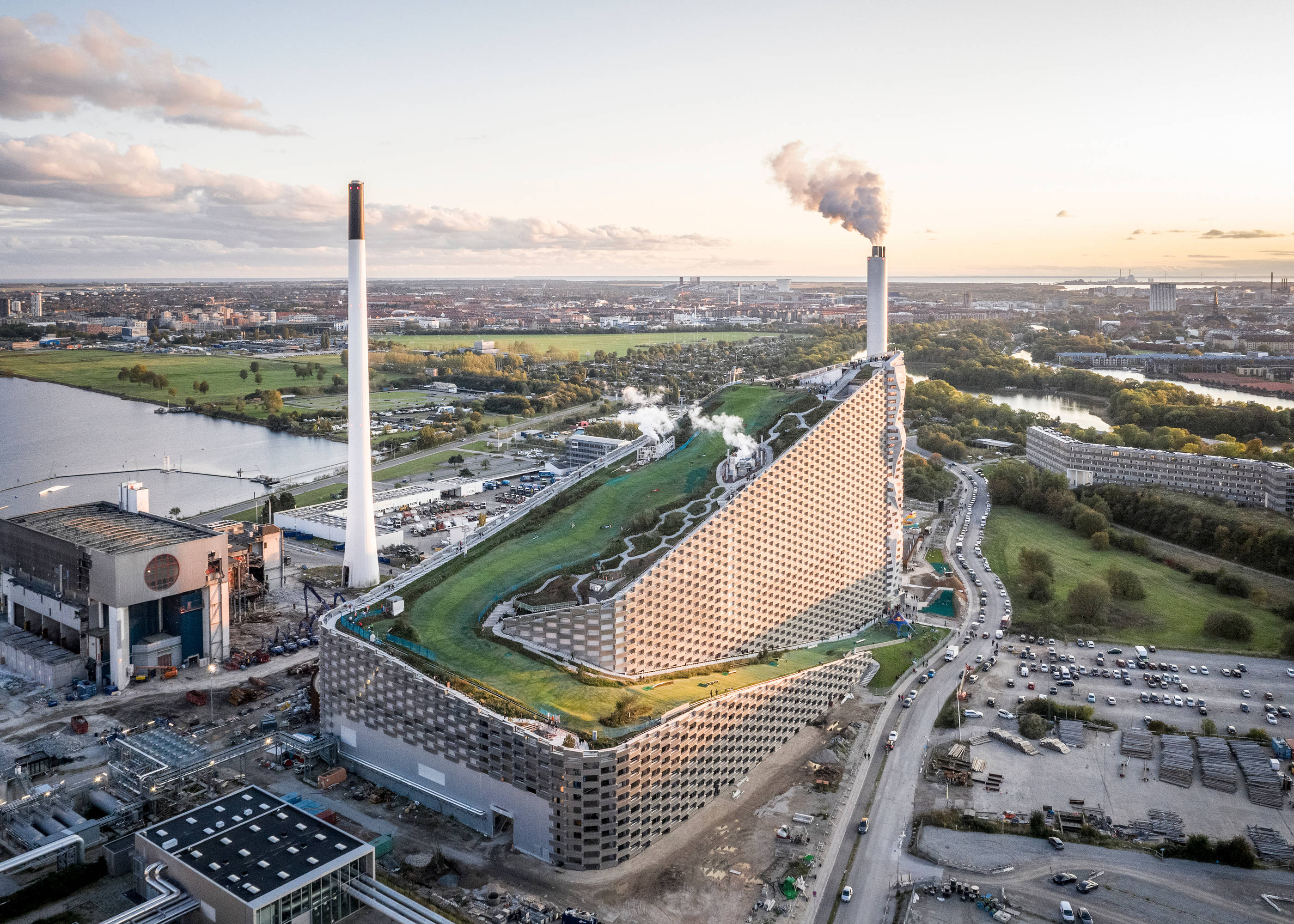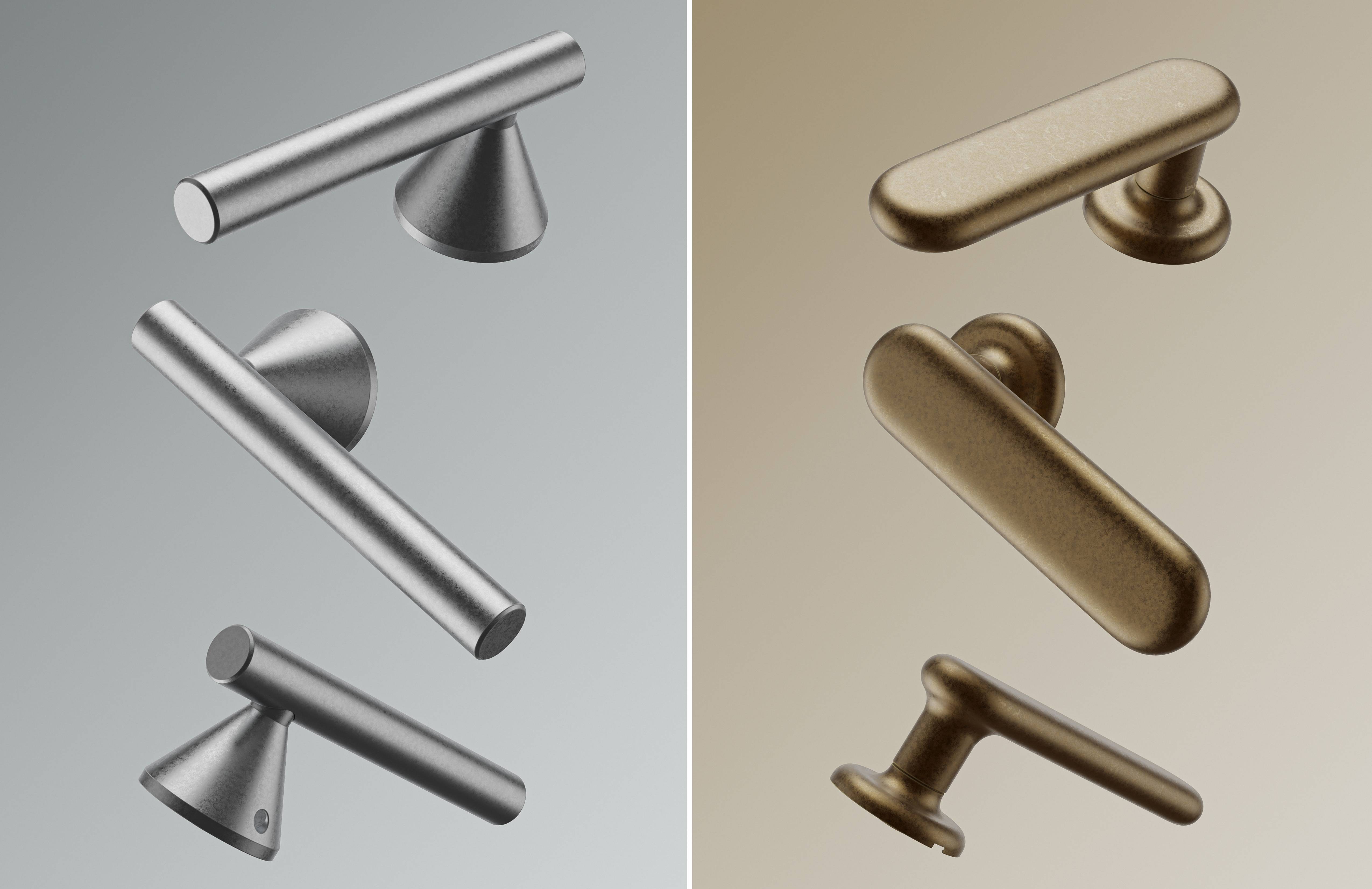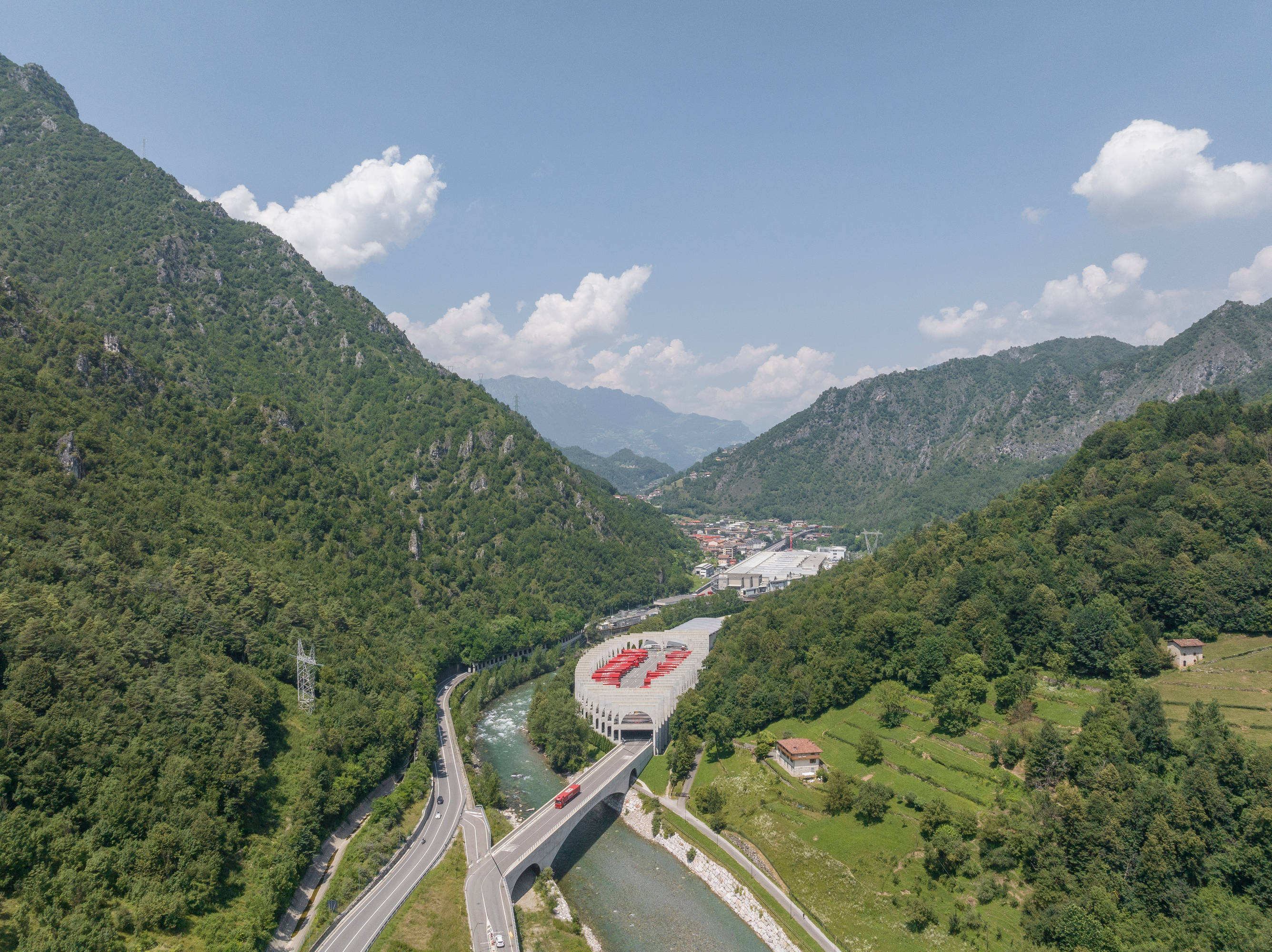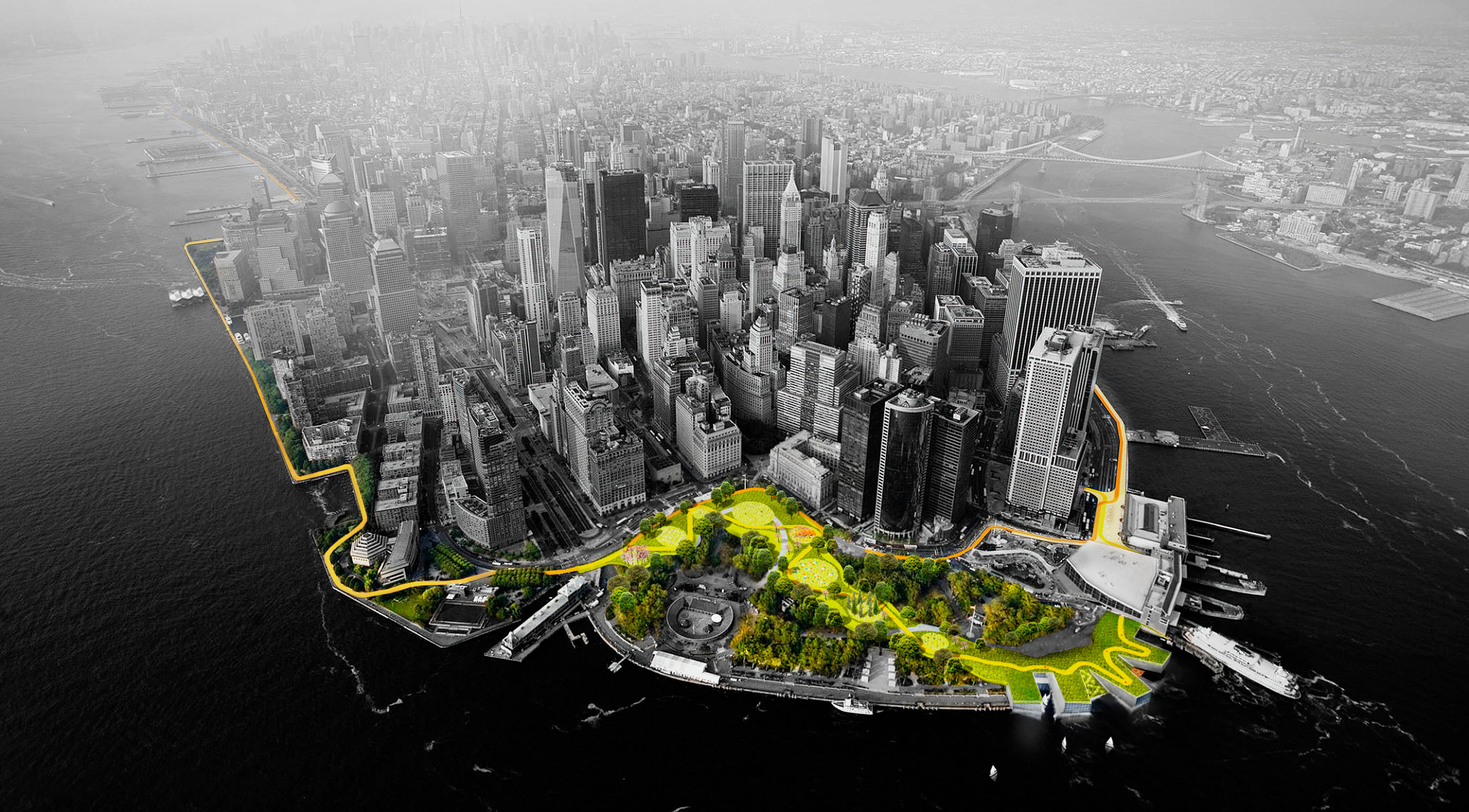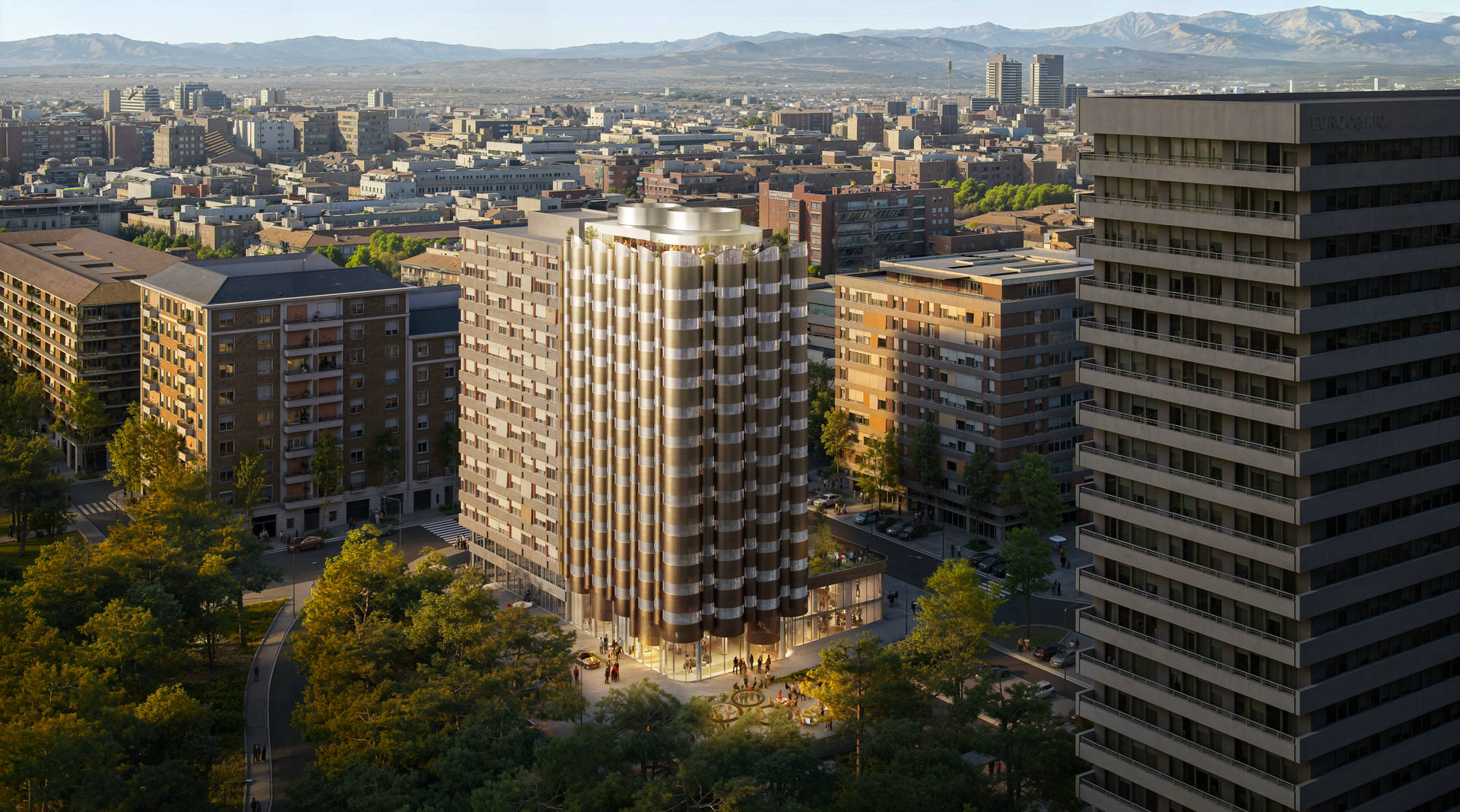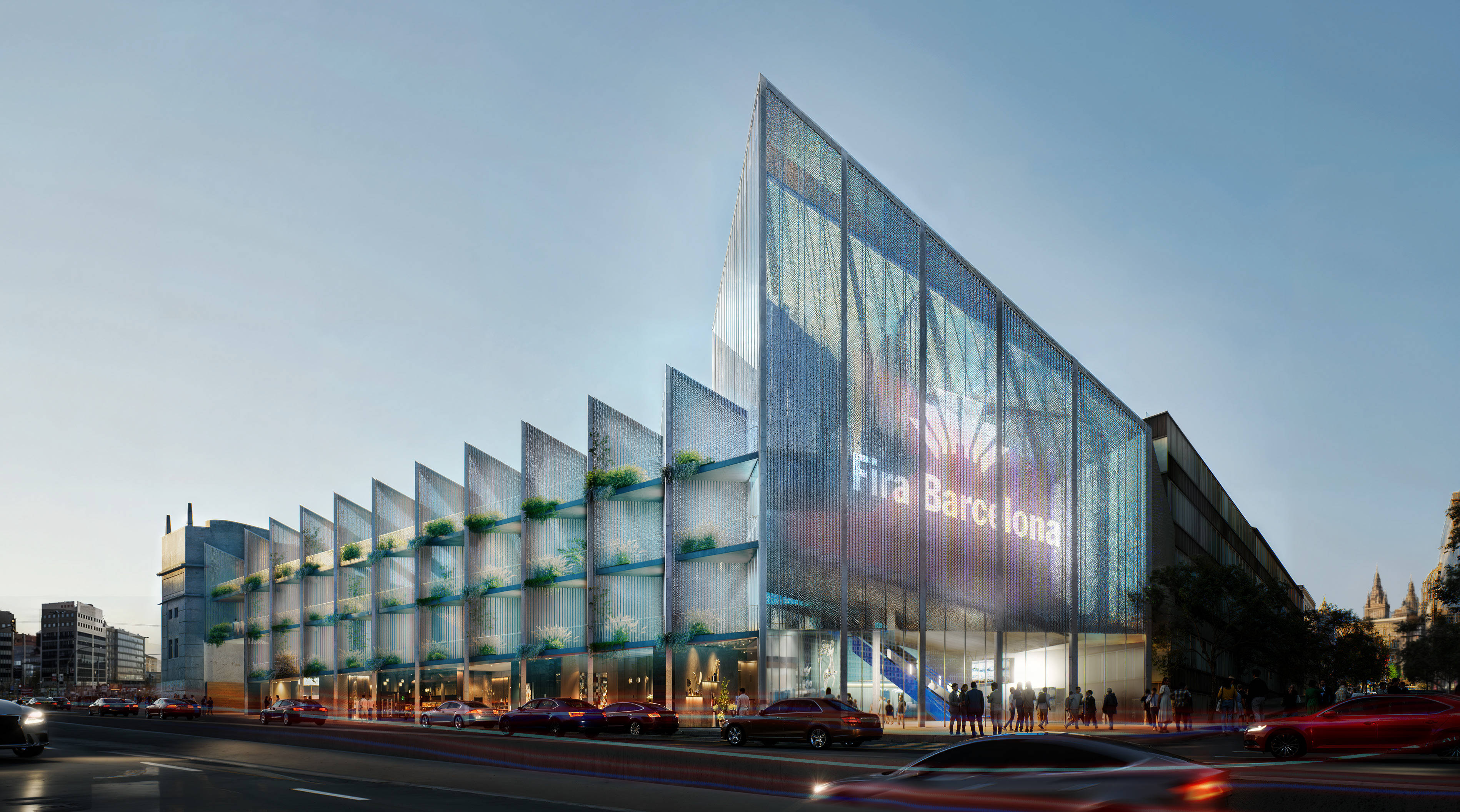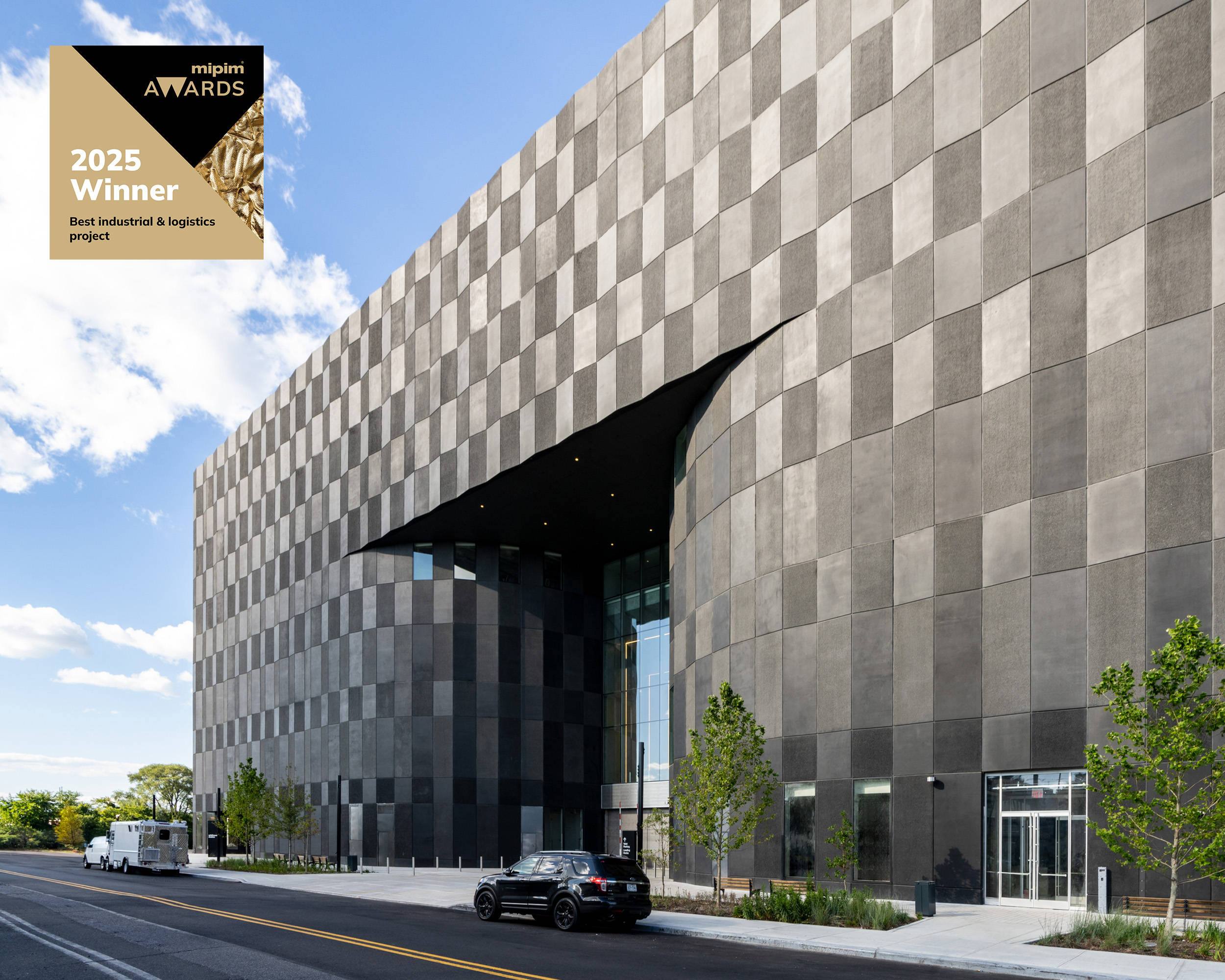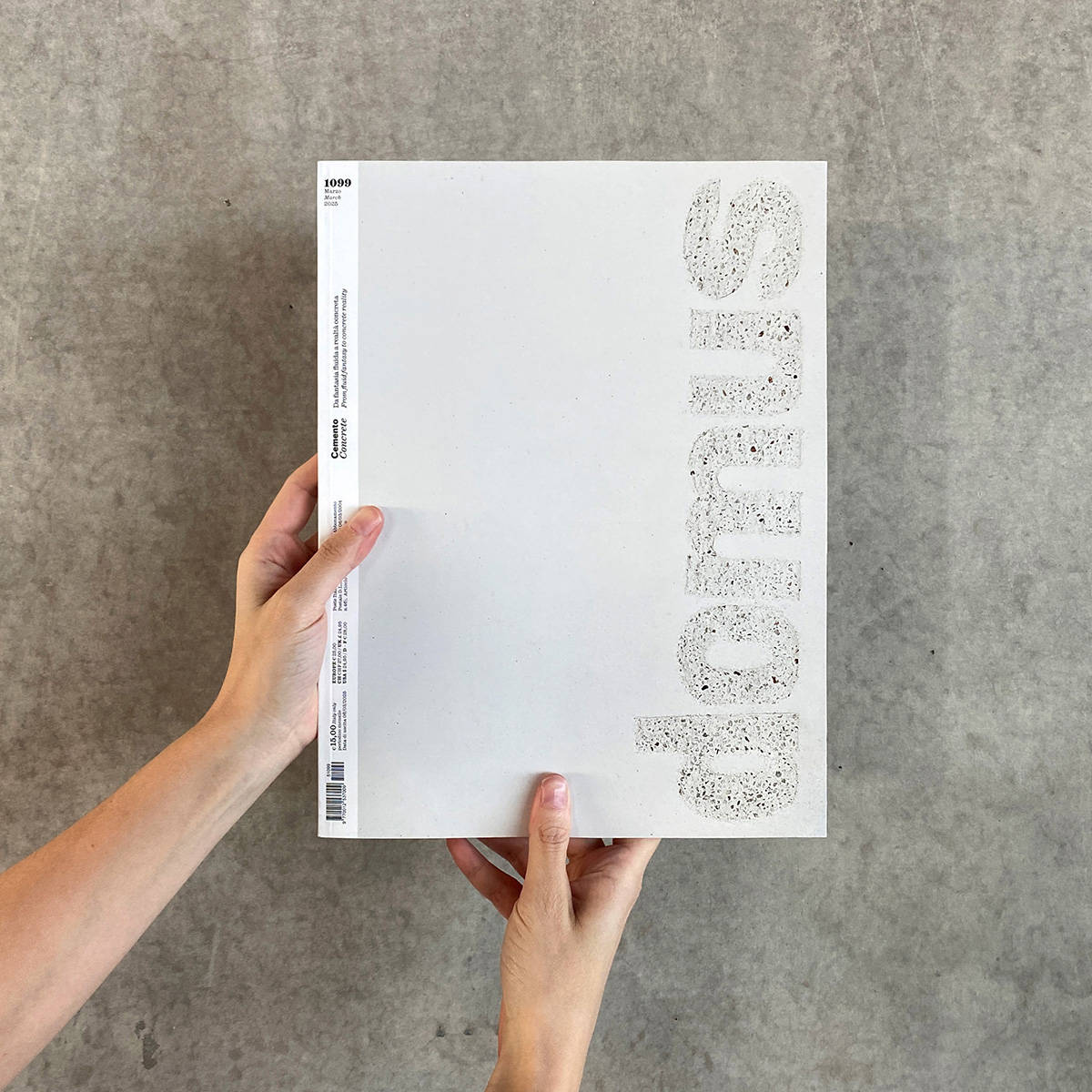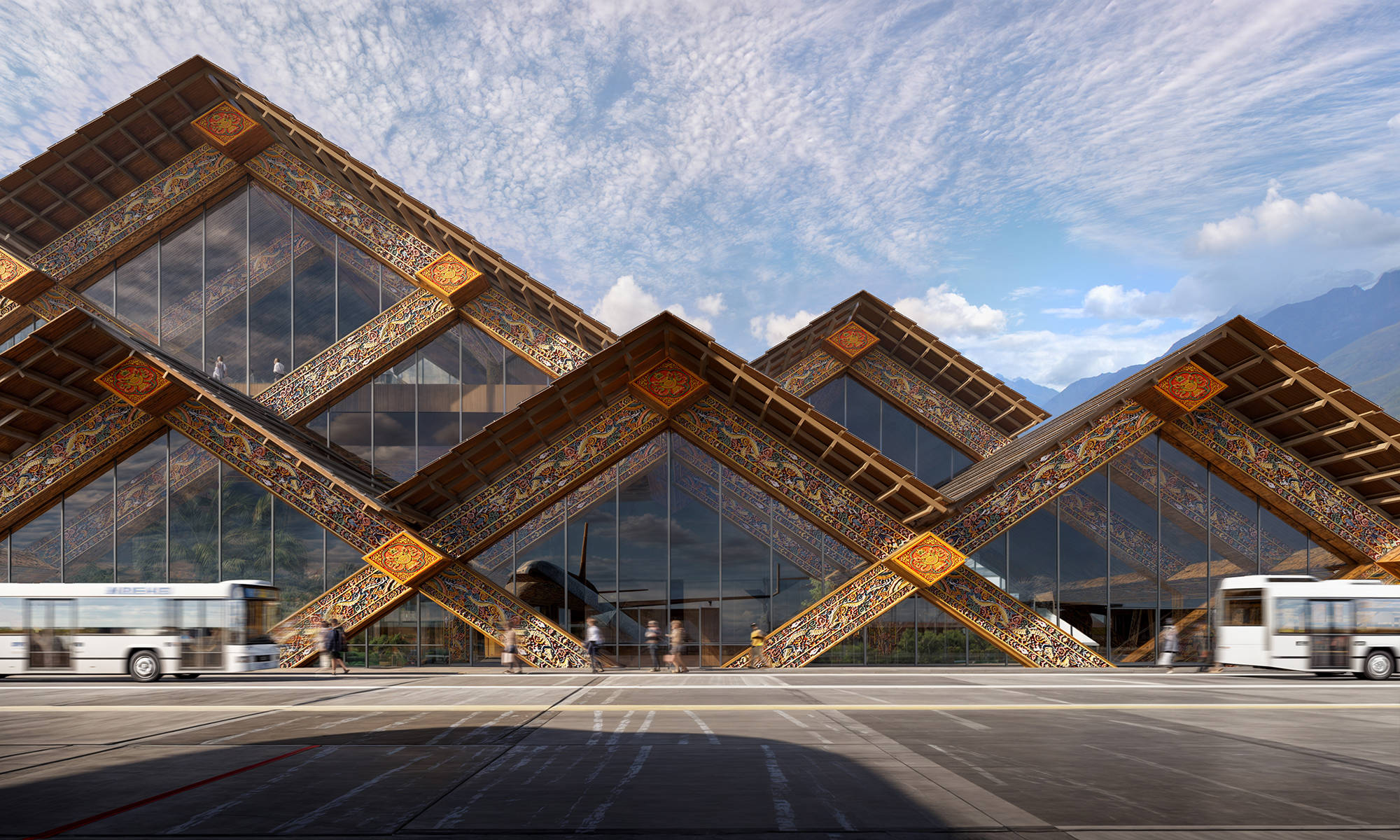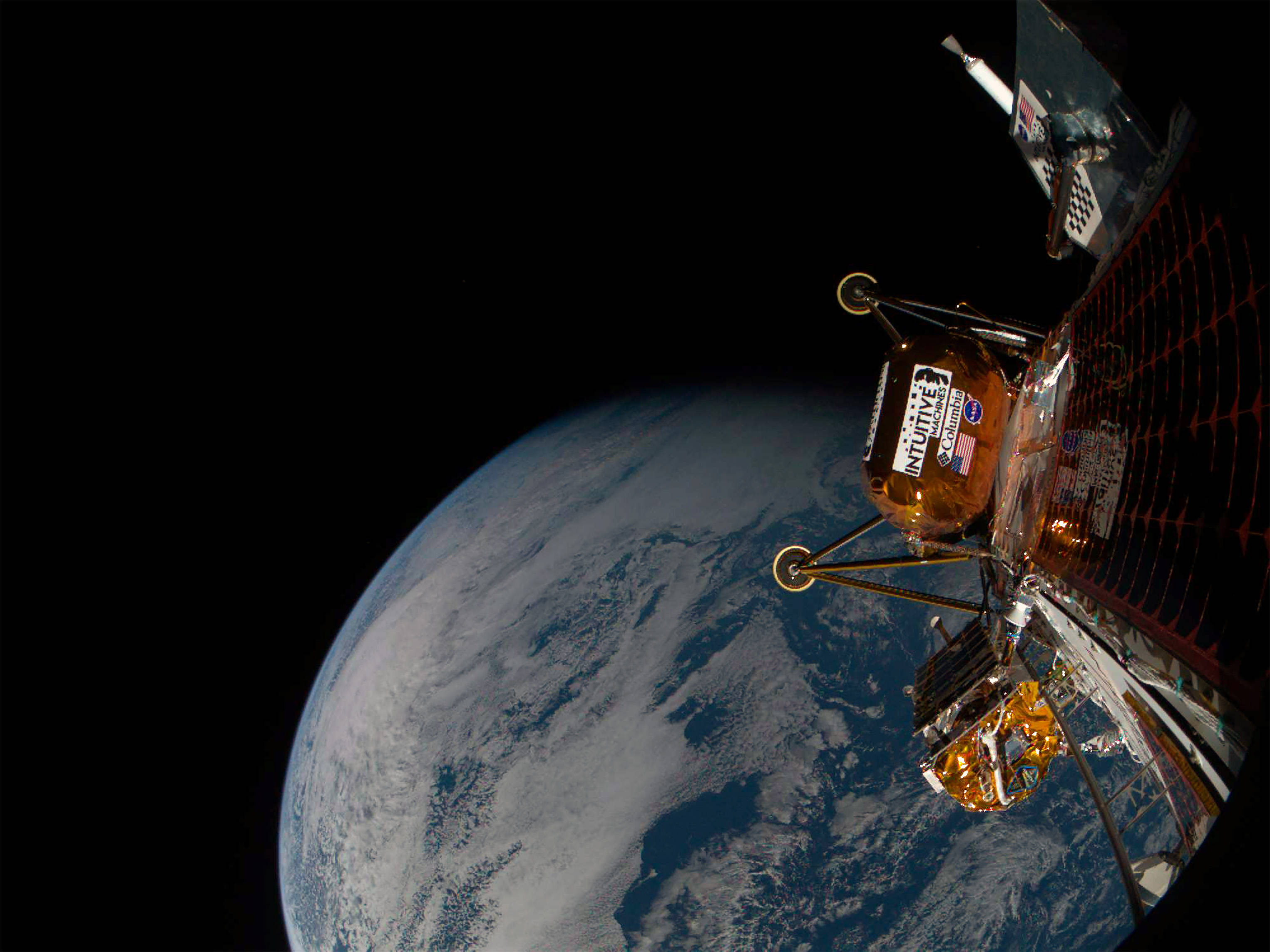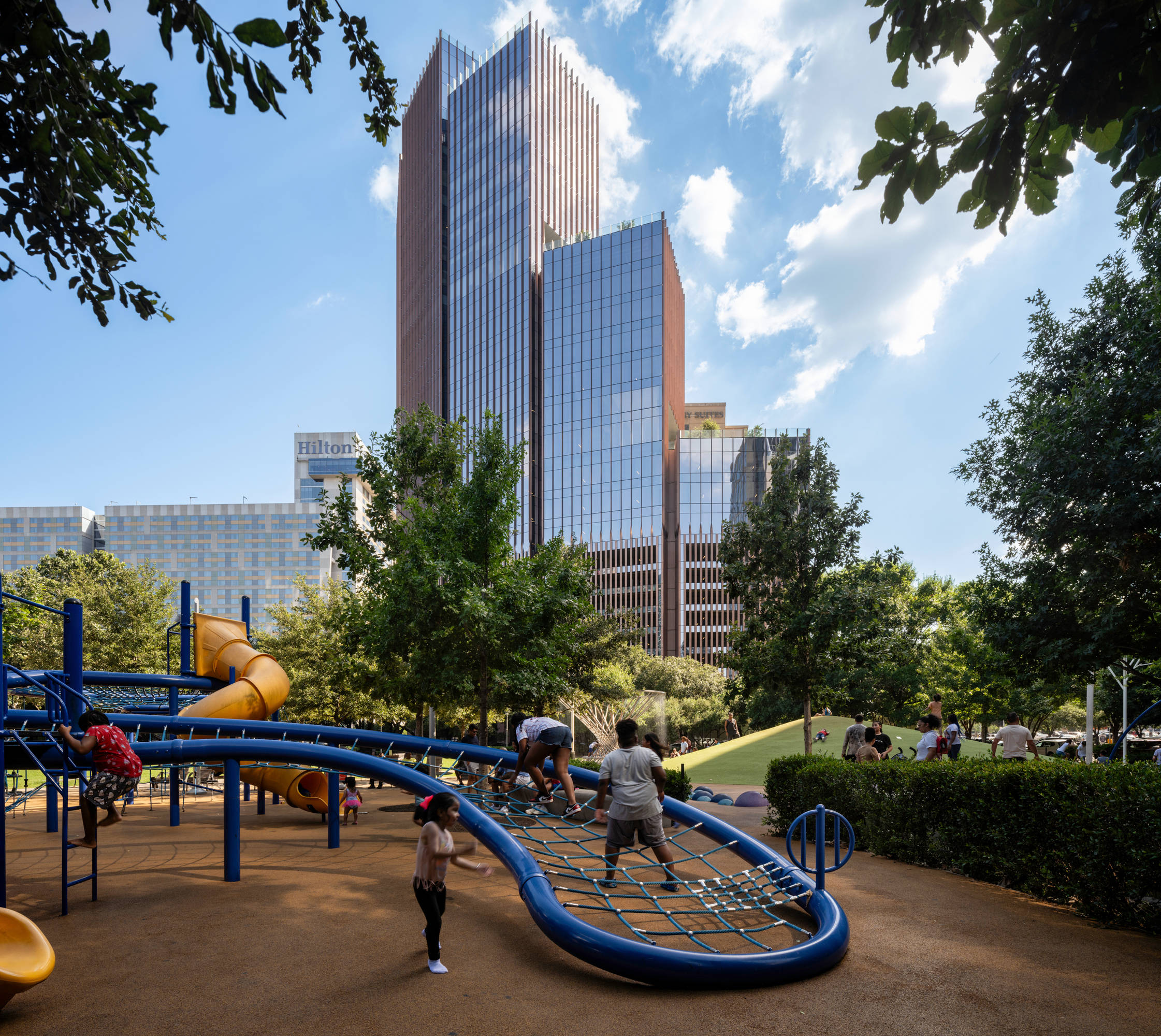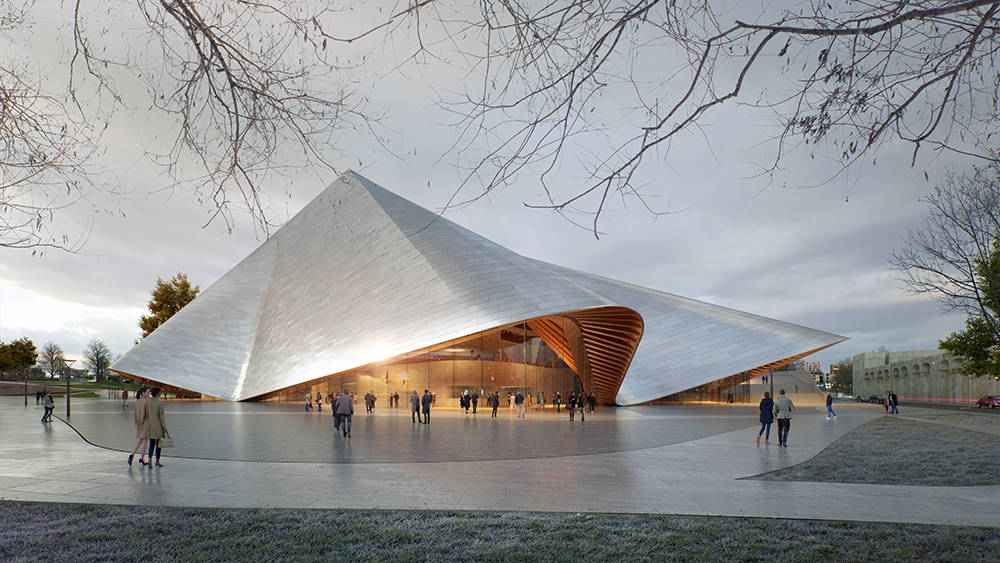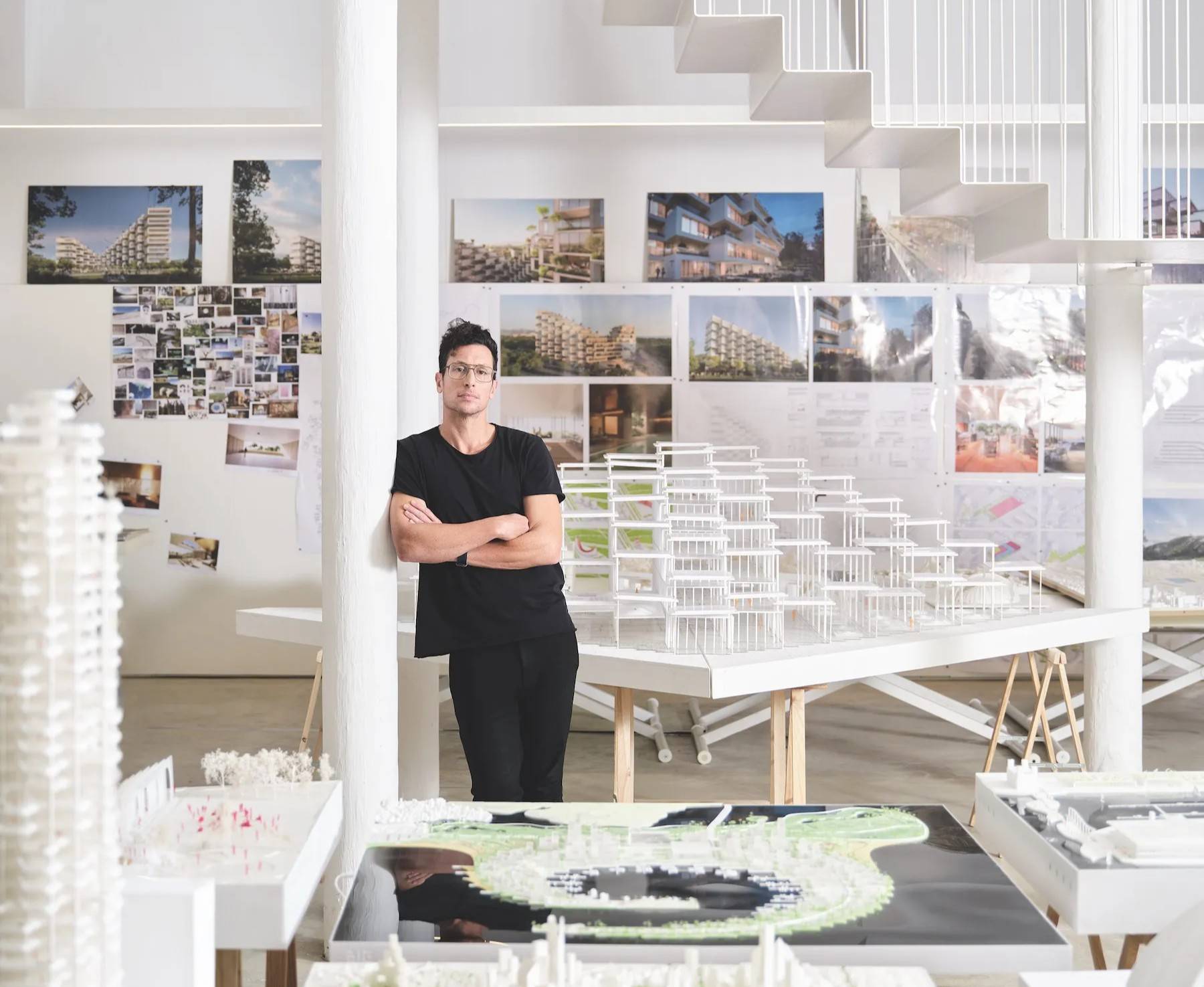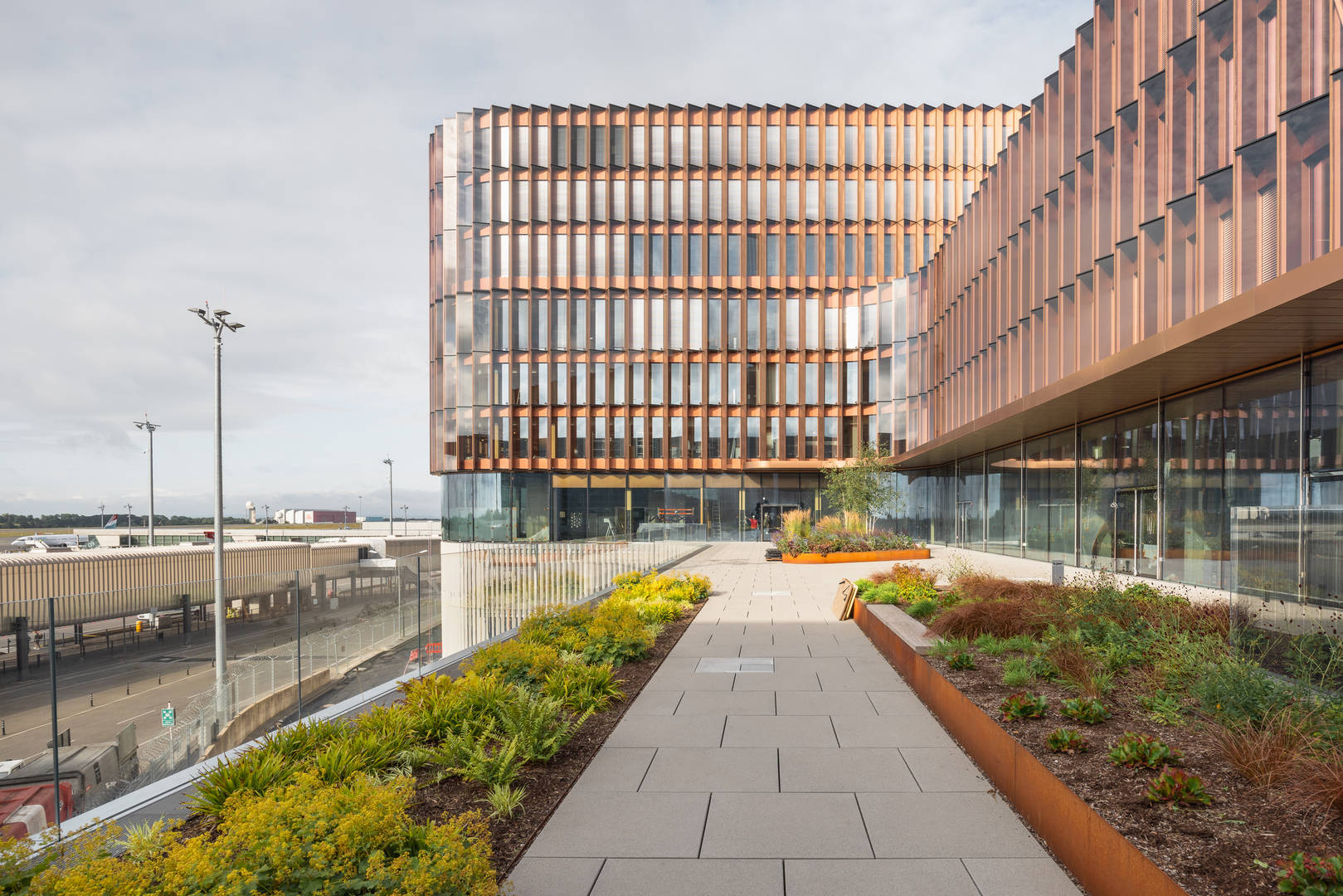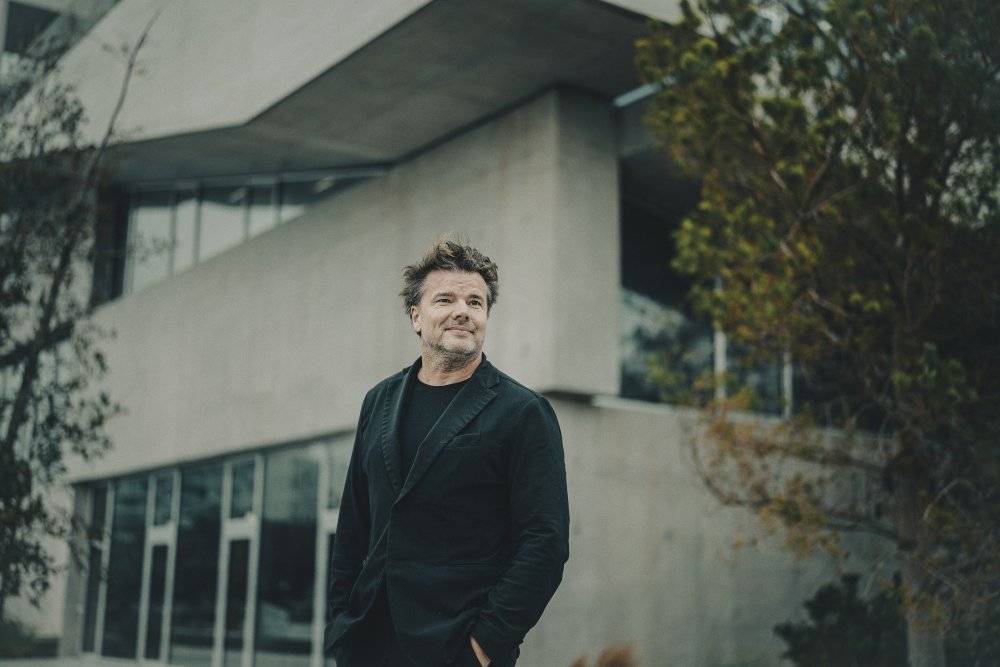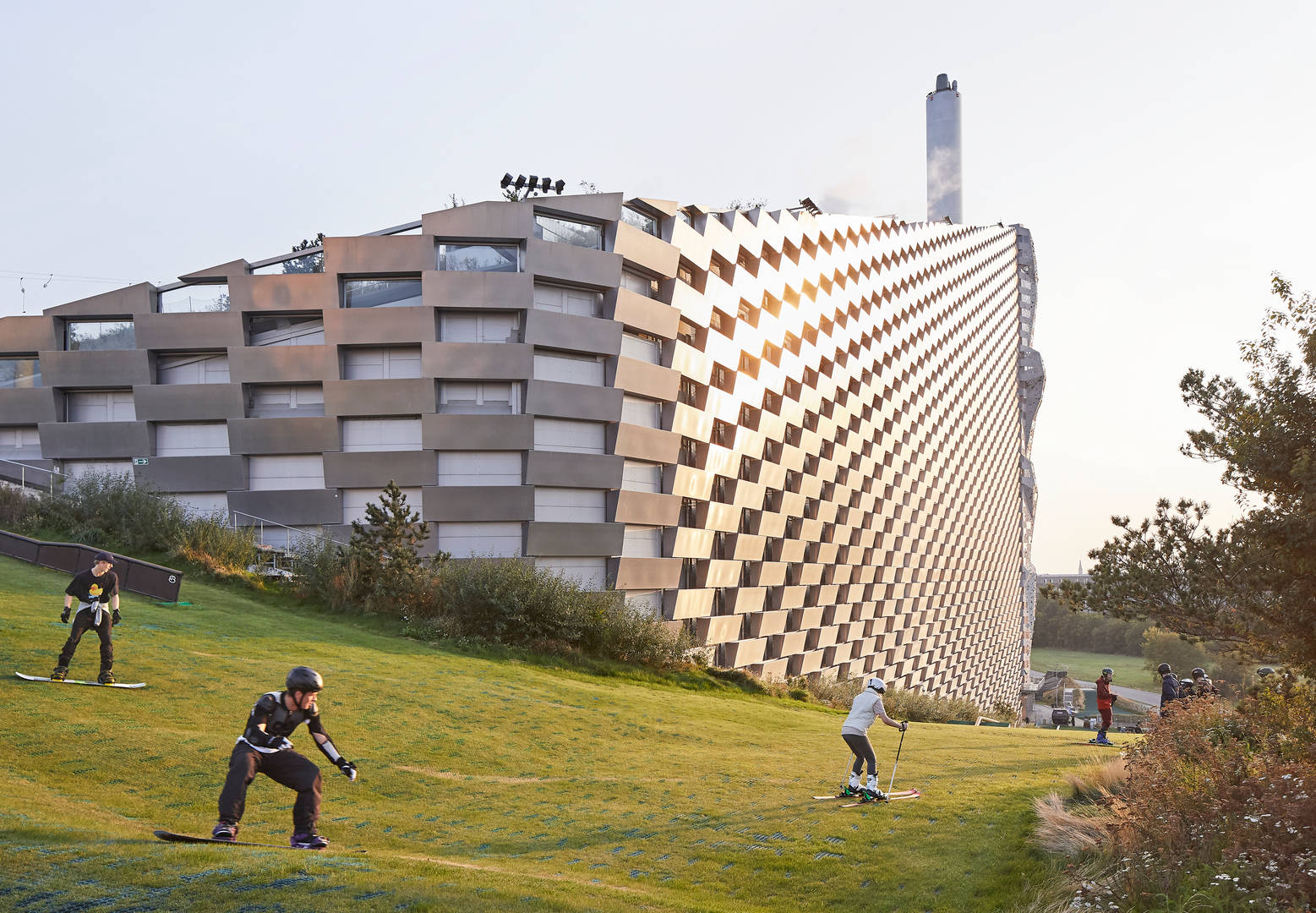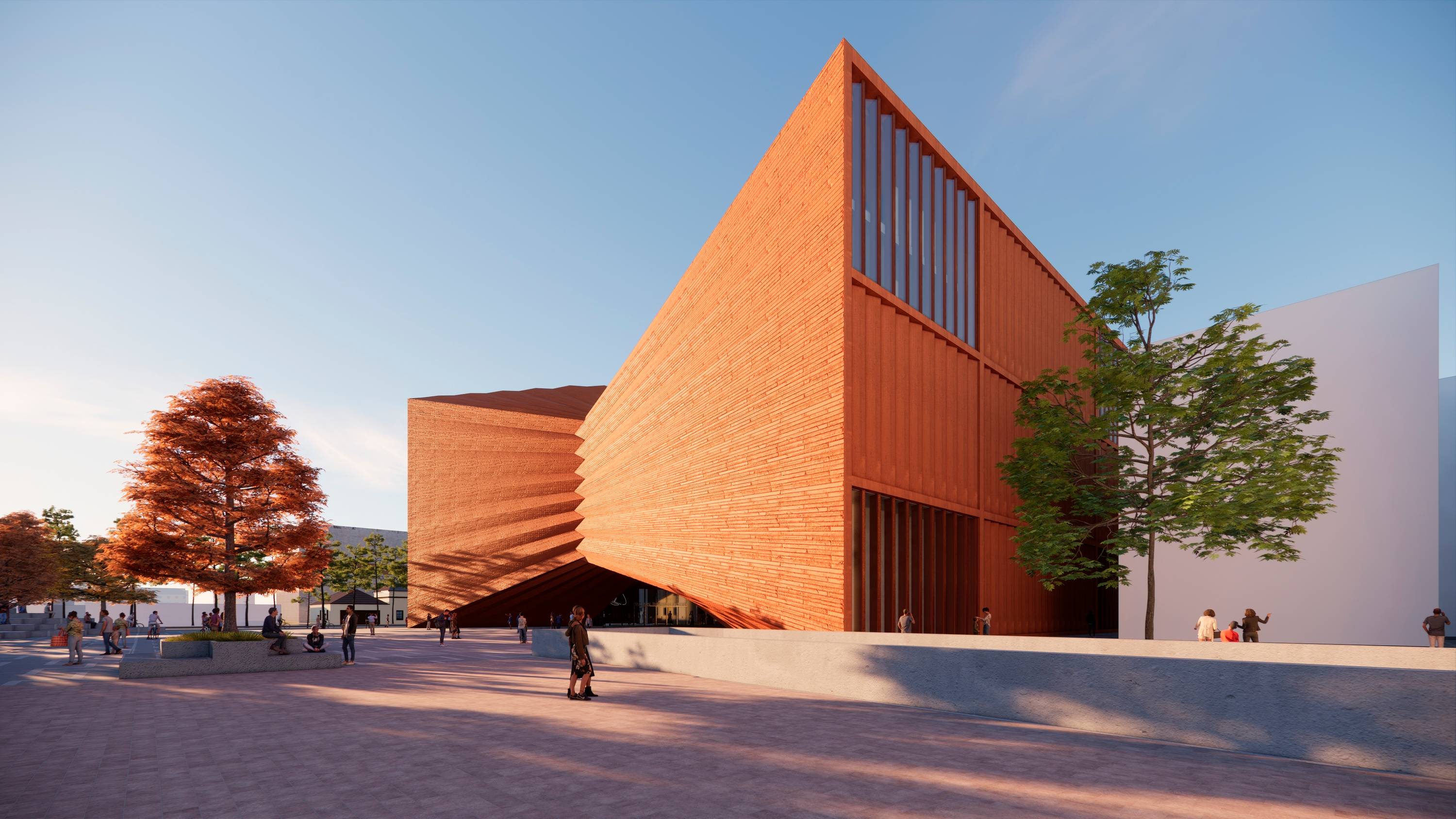NEW PROJECTS
PRESS
LECTURES
EXHIBITIONS
Gelephu Mindfulness City has been recognized as one of four Asia Pacific winners at the 2025 Holcim Foundation Awards for Sustainable Construction – one of the most significant honors recognizing innovation and best practice in sustainable architecture and design. Developed by BIG – Bjarke Ingels Group with Arup and Cistri, the 1000+ km² masterplan in Bhutan envisions a new economic hub shaped by the country’s culture, landscape, and the principles of Gross National Happiness, setting a global benchmark for mindful urban development.
Aldar Properties has announced The Row Saadiyat, a lifestyle and residential quarter designed by BIG with interiors by Kettle Collective. Located in Abu Dhabi’s Saadiyat Cultural District – within walking distance of the Zayed National Museum, the Louvre Abu Dhabi, the Guggenheim, and upcoming Natural History Museum – The Row Saadiyat comprises seven residential buildings arranged around a central linear spine. This spine creates a seamless visual and spatial connection between a mosque at one end and the Zayed National Museum on the other, offering residents unobstructed vistas that celebrate the district’s cultural icons.
Combining vibrant street life with calm, private spaces above, The Row Saadiyat’s ground floors will host dining, wellness, and lifestyle outlets, while amenities include kids’ clubs, a pet spa, a co-working lounge, and a wellbeing club open to residents and the wider community. The mosque, also designed by BIG, blends Emirati vernacular with Saadiyat’s contemporary architecture, featuring a prayer hall that aligns with Mecca and an upper form that orients toward the Zayed Museum. A spiraling ramp connects these elements, creating a fully accessible roofscape and marking the first mosque of its kind inspired by the Malwiya form.
The first phase of sales for 315 one- to three-bedroom homes in The Row Saadiyat opens on November 1st.
The New York Times’ Michael Kimmelman spotlights Manresa Wilds as a leading example of adaptive reuse in a story about potential of obsolete infrastructure to be repurposed into community assets. Located on the site of a decommissioned power plant in Norwalk, Connecticut, Manresa Wilds will revitalize the 125-acre peninsula as a park, nature retreat, and community hub developed in close collaboration with some 3,000 Norwalkers.
The plant buildings at the heart of Manresa Wilds will be reimagined by BIG into a network of event spaces, educational and research facilities, and areas for play, while the publicly accessible park, designed by SCAPE, will feature new waterfront walking paths, an expansive green lawn and meadow, and a public beach. For the first time in nearly 75 years, Manresa Wilds will unlock 1.75 miles of waterfront access, transforming the site into a major public amenity for the city of Norwalk.
The Marengo Multimodal Transport Hub in Toulouse, France, has received its building permit, marking a new step in the development of the 12,000 m² project located next to Gare Matabiau. The six-storey building will bring together bus, rail, metro, cycling, and pedestrian networks under one roof. A rose-colored crystalline roof, referencing the city’s traditional “foraine” brick, rises to 32 m towards the railway tracks. Public areas are planned to extend across the ground floor and two sub-levels, hosting retail, rest spaces, cultural activities, and the Maison du Climat. A 1,000-place bicycle station will be integrated into the site, while the upper floors provide offices for the Occitanie Region.
Construction is scheduled to begin in summer 2026 and finish at the end of 2028, to align with the launch of metro line C and precede the arrival of the Toulouse–Bordeaux high-speed rail line.
A new era of student life has begun at Johns Hopkins University with the opening of the Bloomberg Student Center, a mass timber village designed in collaboration with Shepley Bulfinch and Rockwell Group. As the first student center for Johns Hopkins University, the 150,000-sq-ft building provides a central gathering space for the university’s Homewood campus, featuring 29 “floating” cantilevered roof planes integrated with nearly 1,000 photovoltaic panels. The mass timber structure combines a digital media center, a 250-seat performance space, art and dance studios, music rehearsal spaces, a dining hall, and more all under one roof. Shaped through in-depth research into the students’ needs, the building is transparent by design, welcoming daylight from all sides and offering views into the ever-changing mosaic of student life within.
“Where student activities at Johns Hopkins University were once dispersed all over campus and all over town, they are now collected and clustered at the Bloomberg Student Center – a village of timber pavilions climbing the natural hill on the university’s edge. Like the indoor counterpart of The Beach – the circular sloping front lawn of the Homewood campus – the Student Center is open and inviting in all directions. Tugged into the topography, the center is a four-story building where every floor is directly accessible from the outside, from every side. As the individual timber pavilions join together, they leave generous openings in between, allowing daylight and views to reach every corner of the building. At its heart – underneath the solar paneled rooftops – the creative commons is a cascading, four seasons meeting space for students and faculty – academic, cultural, and social activities alike. The mass timber construction not only substantially reduces the embodied carbon footprint of the building, but also provides an atmosphere of welcoming warmth and inviting informality.” – Bjarke Ingels, Founder & Creative Director, BIG
Vogue Scandinavia Living launches its debut issue with BIG’s Founder and Creative Director, Bjarke Ingels, on the cover. The feature takes readers inside his 1918 summerhouse in Rørvig, Denmark – a red pinewood cottage named Fjordglimt (“a glimpse of the fjord”) that blends Danish tradition with Swedish craftsmanship. In the article, Bjarke reflects on how the historic home has become both a family sanctuary and a source of creative inspiration, influencing his architectural work and approach to restoration.
BIG has won the international competition to design Faith Park – a new 200,000-m² public park on the hillsides outside of Tirana, Albania.
Laid out as a genealogical tree of faith, the park branches from a shared origin in the valley into three routes, guiding visitors through gardens, olive groves, and forested slopes toward nine pavilions – each dedicated to a different spiritual tradition. Framed by gardens inspired by geographic and spiritual origins, the pavilions are constructed in materials including Jerusalem limestone for Judaism; colored Italian marble for Christianity; white sandstone mosaic for Islam; and granite, onyx, marble, and river-polished stone for the Dharmic and East Asian traditions. The Museum of Remembrance is formed from nine rammed-earth volumes arrayed around a central garden, celebrating diversity and unity at the entrance of the Park.
“In the time of the Anthropocene, where our removal from nature and our presence on the planet has become so substantial and so damaging, it seems that we must return to our common roots – to begin worshipping our natural environment, our ecosystem, our shared planet that we call home. In that sense, it feels almost inevitable that the Park of Faith – organized like a livable, inhabitable evolutionary tree of faith mapped onto the natural topography of a mountain, connecting the valley to the summit, the earth to the heavens, and rooted in respect for nature – is a project the world is longing for, whether we know it yet or not.” – Bjarke Ingels, Founder and Creative Director, BIG
In “Recyclate – From Trash to Treasure”, the October issue of Domus guest edited by Bjarke Ingels, we look to the remains of our built world as the resources of the future.
Aaron Betsky makes a case for repurposing rather than building anew, while Anders Lendager looks to the existing built environment as a source of new materials. Olaf Grawert challenges the culture of demolition, and Lacaton & Vassal treat reuse as an act of generosity, extending the life and freedom of what already exists.
Pihlmann Architects transform a 1960s factory in Copenhagen, while Blaising Borchardt Studio gives significance to old rails in their Holocaust memorial. Maxence Grangeot reuses rubble in Cyclopean concrete, and Dirk van der Kooij merges waste plastics into new metamorphic forms. Material Record and Yamaha explore the aesthetics of upcycling with their speakers and guitars. Thomas Deininger scavenges the debris of beaches and parks to celebrate nature with the very waste that threatens it – and creates the cover for this issue, assembling pieces of plastic into an abstract composition of color and waste. Thomas Dambo builds mythological trolls from construction scraps, while Kathleen Ryan turns trash into treasure with her bejewelled still lifes, inspiring the title of this issue.
BIG has won the international competition to design a new congress center in Rouen, France. On the banks of the Seine, the 11,500 m² building, nicknamed ‘The Sail,’ is defined by its roofline that rises and dips above the river. The congress center is envisioned as a public meeting place that links the city to the water while hosting international events, exhibitions and community life.
Commissioned by the metropolitan authority of Rouen, the center will house two auditoriums, exhibition halls, a restaurant, meeting rooms and back-of-house spaces, contributing to the city’s ambition of becoming a destination for international events. Designed in collaboration with BLP & associés, The Sail is designed to achieve Passivhaus certification for highly energy-efficient buildings.
BIG has collaborated with artist studio Humans since 1982 and stone supplier SolidNature on a new series of kinetic timepieces, first unveiled during 3daysofdesign at BIG’s Copenhagen headquarters for the Materialism exhibition. The series consists of two editions, A Million Times 96 and ClockClock 24, crafted from Sunset Dune Travertine – a stone handpicked by Bjarke Ingels for its layered geological character. Drawing on Humans since 1982’s choreographed clock grids, the travertine surface becomes a living canvas where millennia meet minutes. Each piece is hand-assembled in Stockholm using the studio’s proprietary technology.
“The fact that stones – especially sedentary and even metamorphic rocks are like geological calendars, each stratum like a date in a ledger, makes it a beautiful natural illustration of the concept of time. The two coming together – technology and geology, Minutes, Hours and Millenia – seems like inevitability.” – Bjarke Ingels, Founder & Creative Director, BIG
Monocle has included BIG’s Founder & Creative Director Bjarke Ingels in their new publication The Monocle Book of Designers on Sofas, which explores the personal and creative significance of sofas for 50 leading designers and architects around the world.
Photographed on his houseboat in Copenhagen’s harbor, Bjarke is featured with the Brick sofa, designed by BIG’s product design team in collaboration with Lithuanian firm Jot Jot. The piece takes inspiration from the sandbags that line the city’s waterfront – tying the piece to his daily surroundings and life.
The Financial Times has published a story on BIG’s new masterplan in Dubai and the emirate’s ambition to embrace a Copenhagen-style model of sustainable, community-focused living.
The article includes an interview with BIG Partner João Albuquerque, who discusses how greenery and shaded public spaces are central to the design strategy, creating comfortable, walkable environments that respond to Dubai’s climate. João highlights how the masterplan aims to foster social interaction, cycling and pedestrian activity, reimagining urban life in a city traditionally defined by the car.
Architectural Record, the U.S.-based architecture and interior design magazine, features Wildflower Film Studios in its October issue focused on cultural projects. Writer Clifford A. Pearson describes the NYC studio as possessing both “heft and dexterity,” highlighting the challenges of designing a film studio within New York’s dense urban fabric.
As the world’s first vertical media production village, Wildflower Studios stands as a 145-ft-tall structure clad with precast concrete panels, which are set at angles that create an animated effect on the façade as the position of the sun changes throughout the day. The “village” features an elevated L-shaped interior street; 11 stacked soundstages; oversized “elephant elevators” to accommodate large-scale equipment and sets; and a 150,000-sq-ft solar panel footprint.
The Robert Day Sciences Center is now welcoming students, professors, staff, and visitors at Claremont McKenna College – one of the nation’s top liberal arts colleges. The 135,000-sq-ft building is designed to maximize multidisciplinary integration and interaction, with each level oriented in a different direction, channeling the flow of people and ideas between the labs, classrooms, and surrounding campus. Commissioned in 2020, the center is BIG’s first built project in Los Angeles and the first completed building in the BIG-designed masterplan for CMC’s Roberts Campus, which envisions a more unified campus shaped by a series of buildings that extend the central mall and adjacent sports bowl. Collaborators on the Sciences Center include Saiful Bouquet as Structural Engineer, KPRS Construction as General Contractor, and IDS Real Estate Group as Construction Manager.
“The Robert Day Sciences Center brings together computer science, data science, and life sciences in one integrated environment. As the first completed building of our master plan for Claremont McKenna, it extends the north mall into a zigzag of malls, becoming a distributor of flows for the entire campus.
We imagined the Sciences Center as a series of parallel building volumes side by side – with a public space in between – that are rotated in all the same directions as the mall. Even though each of the individual building volumes are rational, flexible, and capable of being computer labs or wet labs, the open atrium in between becomes a Piranesian social space where you can see fellow students, faculty, colleagues, and professors from every level. So even if you spend most of your time in a wet lab, computer lab, or classroom, there will still be many opportunities for sparks to fly between you and your fellow students, stimulating the exchange of ideas across the traditional silos of knowledge. In that sense, the Robert Day Sciences Center becomes a crucible where all of the different kinds of knowledge and all of the different kinds of students and teachers come together in one complex, three-dimensional learning environment.” – Bjarke Ingels, Founder & Creative Director, BIG
Taking its first steps as a real-world test course for mobility, Toyota Woven City has welcomed its first residents at the foothills of Mt. Fuji in Susono City, Japan. Phase 1 of the Woven City, designed by Nikken Sekkei with the masterplan, public realm, and landscape by BIG, brings together ‘Inventors’ – enterprises, startups, entrepreneurs, and researchers – and ‘Weavers’ – its residents and visitors – into a living laboratory for mobility, autonomy, connectivity, hydrogen infrastructure, and industry collaboration. By combining the legacy of Japanese craftsmanship with modern technology, Japan’s construction heritage lives on, while building sustainably and efficiently into the future.
Toyota Woven City Phase 1 will welcome about 300 residents, with the city slated to open to the public in April 2026.
The hotel within BIG’s Irmahus development on Aarhus Ø has been revealed as Bassin Seven and is set to be Scandic’s first signature hotel in Denmark. Designed by BIG, the 342-room hotel is conceived as an “urban resort,” featuring a 2,000 m² spa across three levels, restaurants, cafés, a rooftop bar, and plazas that open the building to the city.
Irmahus is designed as a vertical neighborhood, with retail and offices on the lower floors and an 80-meter spiraling public stair leading to a panoramic rooftop. Set to open in early 2027, Irmahus will complete the BIG-designed Aarhus Harbor Masterplan, which has transformed the former industrial waterfront into a new urban district for living, working and gathering.
German daily newspaper, Hamburger Abendblatt, has featured BIG in an in-depth interview on the competition for the new Hamburg Opera, speaking with BIG’s Founder & Creative Director Bjarke Ingels and Partner Jakob Sand.
The piece introduces BIG as one of five architecture teams invited to develop proposals for the future opera house at Baakenhöft in Hamburg, marking an important step toward one of Germany’s most significant cultural projects. The winning design will be announced at the end of 2025.
Returning for its second year, the NOT A HOTEL DESIGN COMPETITION is now open for entries, inviting architects and creators under 40 to design a villa on the scenic island of Yakushima, a southern Japanese island off the coast of Kagoshima. The competition jury includes BIG’s Founder and Creative Director Bjarke Ingels, architect Sou Fujimoto, and interior designer Masamichi Katayama. The winner will be announced in March 2026 and awarded a ¥10 million prize, with the design brought to life by NOT A HOTEL on Yakushima Island.
I AM MSHRM, a modular pavilion made from 3D-printed recycled plastic and mycelium, opened at Herningsholm College in Denmark. Designed together with Danish AM Hub, MDT and Naturpladen, the installation explores how additive manufacturing and bio-based materials can support circular construction, allowing the pavilion to be disassembled, reassembled and reused.
On the opening day, 150 students took part in workshops and discussions about the future of building, imagining how technology and new materials could address climate challenges in 2125.
The Copenhagen Harbor Bath is featured in The Globe and Mail, Canada’s most widely read newspaper, in a story on Copenhagen’s year-round outdoor swimming culture and the transformation of the city’s harborfront. Completed in 2002 as the first of the city’s modern harbor baths – as well as one of BIG’s first projects – the Copenhagen Harbor Bath introduced five saltwater pools and wooden decks that transformed the cleaned-up canal into a destination for locals and visitors alike.
Published by Rizzoli, AD at Home chronicles Architectural Digest’s most memorable home tours during Amy Astley’s decade-long tenure as editor in chief. Spanning nearly 500 pages, the coffee table book highlights the private spaces of leading figures across fashion, music, film, art, and design – from Marc Jacobs’ Greenwich Village townhouse and Troye Sivan’s Melbourne home to BIG’s Founder and Creative Director Bjarke Ingels’s own houseboat, Brukken Bruse.
Faena New York, the third namesake hotel from hotelier Alan Faena, is now open and welcoming guests on Manhattan’s west side. Located within One High Line’s East Tower, designed by BIG, the hotel brings Faena’s signature blend of modern luxury, avant-garde art, and visionary ethos to West Chelsea. The 120-room property features La Boca by Francis Mallmann, a 5,000-sq-ft restaurant led by the renowned Argentine chef; a 17,000-sq-ft spa, Tierra Santa Healing House; and a dedicated theater space for events and performances.
The new Solar One Environmental Education Center – designed by BIG in collaboration with the NYC Economic Development Corporation (NYCEDC), Gilbane Building Company, TY Lin (formerly Silman), Cosentini Associates, MNLA Landscape Architects, and others – has opened in Manhattan’s Stuyvesant Cove Park. A ribbon cutting ceremony – which included speeches by NYCEDC President & CEO Andrew Kimball, Solar One CEO Steve Levin, New York City Council Member Keith Powers, BIG Founder and Creative Director Bjarke Ingels, and Gilbane Vice President Raquel Diaz – commemorated the milestone.
Defined by FSC-certified timber slats on the exterior and a roof fully clad in photovoltaic panels, the 6,409-sq-ft center expands nonprofit group Solar One’s mission of environmental education and stewardship, including flexible classrooms for educational programming, community functions, office use, and other community opportunities. The center minimizes the use of concrete – employing the material only at the flood level while incorporating lightweight, recyclable steel in the spaces above. The classrooms are elevated 19 ft above sea level, with ground-level storage areas enclosed by permeable metal grating, allowing water to flow freely during storm events. Inside, floor-to-ceiling windows frame sweeping views of the East River, Brooklyn, and Queens, while triple-glazed, bird-friendly glass mitigates sound from the adjacent FDR Drive. The center serves as the northern gateway to the BIG-led East Side Coastal Resiliency Project (ESCR), a 2.5-mile flood protection system designed to improve the resiliency of critical infrastructure and over 110,000 New Yorkers. Seamlessly connecting to Stuyvesant Cove Park’s promenade of connected terraces and gardens, the Solar One Environmental Education Center creates an engaging real-world learning experience right at the edge of the East River.
“The Solar One Environmental Education Center stands as more than a building, it’s a classroom for the city – a meeting point where architecture, nature, and community converge. Clad in timber and photovoltaic panels, the center’s angled roof acts as both a renewable energy source and a teaching tool. Inside, flexible classrooms support an immersive, hands-on learning experience for New Yorkers from an elevated position overlooking the East River and Stuyvesant Cove Park. Made possible by the vision and dedication of many, our hope is that this center inspires curiosity, responsibility, and imagination – empowering generations to shape a more sustainable and resilient future together. BIG is honored to bring the project to life as both a model for future urban resilience and a home for curiosity, community, and responsibility.” – Ryan Harvey, Senior Architect, BIG
The New York Times profiles ICON, the Austin-based construction technology company pioneering 3D-printed homes to address the housing crisis and climate change. At the heart of the story is the largest 3-D printed housing community in the U.S., Wolf Ranch – a collaboration between Lennar, ICON, and BIG. Made up of 100 homes in Georgetown, Texas, Wolf Ranch was built from “lavacrete” – a proprietary mix of lava rock, cement, and water – using ICON’s 4.75-ton Vulcan printer. Reporter Debra Kamin spoke with BIG’s Founder & Creative Director Bjarke Ingels for the piece, adding his perspective on housing innovation.
“Plant – Living Materials for Human Habitats”, the September issue of Domus guest edited by Bjarke Ingels, looks to the world of plants and explores how vegetation can re-root urban life in living systems.
Julia Watson looks at Indigenous systems where land is cultivated without architects, and Ben Lamm turns to bioengineering to bring back extinct species. Günther Vogt shows us the landscape as an interspecies neighborhood shaped by climate change and glacial retreat, while Piet Oudolf choreographs plantings like seating plans.
At Urban Farming Office, Vo Trong Nghia blurs food, façade and foliage, Field Operations tops a highway tunnel with a manmade coastal landscape and Nongzao grows mycelium in everyday plastic moulds. From edges to orbit, Azuma Makoto sends delicate botanical arrangements to the edges of the Earth, and Andrew Zuckerman reveals insect morphology at human scale.
Diriyah Company has announced the launch of The Chedi Residences Wadi Safar, designed by BIG and developed in partnership with Chedi Hospitality. Set within the cliffs of the Wadi Safar district in Diriyah, Saudi Arabia, The Chedi Residences Wadi Safar is a collection of 20 branded villas featuring 16 four- and five-bedroom villas, as well as four five-bedroom premium villas. The residences showcase Najdi-inspired architecture integrated into the natural landscape, offering privacy, harmony, and uninterrupted views over the Greg Norman-designed Signature Golf Course.
Residents will have access to a full suite of amenities, including access to the forthcoming adjacent 85-key Chedi hotel, signature dining, wellness and fitness facilities, curated retail, and a private residents’ club featuring a lounge, business corner, and event spaces.
Quito, Ecuador continues its rise as a global design destination, with new towers by international architects reshaping the city’s skyline. Vogue highlights how the city’s blend of contemporary architecture, a UNESCO-listed historic core, and vibrant creative neighborhoods is turning the Andean capital into South America’s next design hotspot.
The article features IQON, a 130-m-tall tower designed by BIG with an architectural identity defined by its ‘stripped back’ façade; the raw, exposed concrete simultaneously functions as the building’s structure. Individual ‘pixels’ are stacked and rotated to provide the best possible views while simultaneously creating terraces for the apartments. Celebrating native trees and plants, the building integrates greenery wherever possible to take advantage of Ecuador’s temperate climate and ecology – the country with the most plant species per square meter in the world.
The Swiss Federal Department of the Environment, Transport, Energy, and Communications (DETEC) has approved the construction of a new air traffic control tower at Zurich Airport. Replacing the existing 40-year-old tower, the new structure will be a part of the new Zurich Airport Dock A, providing controllers an improved overview of ground and air operations. As the first part of the airport complex to be built, construction on the tower is scheduled to begin in 2027, with an anticipated opening in 2035 – operating as a free-standing structure until the completion of the new Dock A.
Zurich Airport’s new Dock A – designed by BIG, Itten+Brechbühl AG, Buro Happold, PIRMIN JUNG, NACO, EBP, Haerter & Partner AG, TLP, and many others – includes Schengen and Non-Schengen gates, airside retail, lounges, offices, the new air traffic control tower, and an extension of the immigration hall. The design is conceived as a mass timber space frame that is structural design, spatial experience, architectural finish, and organizational principle in one. The structure is made from timber, and the roof is entirely clad in solar shingles, turning sunlight into a power source.
CURIN, a new online platform for curated creative content, has launched with a selection of architecture works handpicked by BIG Founder and Creative Director Bjarke Ingels. For two weeks, Bjarke will curate the architecture section of the platform, sharing his perspectives on projects including Ensamble Studio’s Ca’n Terra in Menorca, an abandoned stone quarry transformed into a dwelling; Anne Holtrop’s Green Corner Building, a cultural center in Muharraq, Bahrain; Sabine Marcelis’s Beyond the Surface Table, made from travertine stone and color-treated glass; and the Noma Garden in Copenhagen, designed by Piet Oudolf.
The BIG HQ Park in Copenhagen is featured in an article by Architectural Digest Spain, exploring the Danish capital as a global benchmark for design, sustainability and quality of life. The piece highlights the HQ’s transformation of a former parking lot into a 1,500 m² public park and promenade as an example of how new green spaces are shaping the city’s identity. Inspired by Denmark’s coastal forests and sandy beaches, the park strengthens local biodiversity and creates a new waterfront destination for staff, neighbors and visitors alike.
Wallpaper* spotlights Bjarke Ingels, Founder and Creative Director of BIG, exploring his concept of ‘hedonistic sustainability’ and showcasing 10 key projects from BIG’s global portfolio. The feature spans early works such as The Mountain and the Danish Maritime Museum, as well as more recent projects like The Twist and Hôtel des Horlogers.
The in-depth piece also references Bjarke’s “archicomic” manifesto, Yes Is More, which the article’s writer, Edwin Heathcote, argues encapsulates BIG’s philosophy:
“Architecture seems entrenched between two equally infertile fronts: either naively utopian or petrifyingly pragmatic. Rather than choosing one over the other, BIG operates in the fertile overlap between the opposites—a pragmatic utopian architecture that takes on the creation of socially, economically, and environmentally perfect places as a practical objective.” – Bjarke Ingels, Yes Is More
The Los Angeles City Council approved the BIG-designed 670 Mesquit, bringing the development one step closer to realization. Located along the Los Angeles River in the LA Arts District, 670 Mesquit is a mixed-use stepped complex consisting of four connected buildings reaching as high as 34 stories. The development will feature 676,000 sq ft of office space, approximately 895 residential units including low-income housing, a 271-room hotel, a charter elementary school, retail and restaurant spaces, a gym, gallery space, and more. At the new 670 Mesquit, the freedom of the neighborhood’s typical warehouse loft meets the individual customization of the stick-built house. The large size of the modules allows interior spaces to be subdivided based on program types and tenant needs. Bridging the gap between the Arts District and the Los Angeles River, a proposed park will be built above the existing freight rail line, fulfilling the long-awaited goal for the neighborhood.
BIG Partner Agustín Pérez Torres spoke to daily newspaper El Periódico to discuss BIG’s winning proposal for the future Fira Barcelona Business Hub – one of three major projects reimagining the historic Montjuïc fairgrounds ahead of their centennial in 2029.
Located at a key entry point to the city of Barcelona, the project transforms the former Palau del Vestit into an open, accessible, and civic destination in the city. In the interview, Agustín describes the design as “a generous, urban response” that removes barriers, introduces a new public plaza and garden while retaining the existing columned structure.
The July-August issue of DOMUS, guest edited by Bjarke Ingels, turns its focus to “Fabric and Plastic – Soft Sidekicks for Solid Structures” in an exploration of textiles, membranes, and pliable surfaces as vital architectural agents.
In this issue, Alejandro Zaera-Polo examines façades as both environmental interface and cultural expression and Petra Blaisse shares her experiences of textiles and fabrics, color and patterns. Nick Tidball shares how fashion can be a testbed for material experimentation and wearable architecture, while José Selgas and Lucía Cano of SelgasCano reflect on their early fascination with industrial readymades.
MAD explores fabric at two scales – a tensile stadium and a single-occupant bubble, Increments Studio and Practice on Earth constructs layered shells that rethink softness as structure. MVRDV weaves recycled plastic into a public carpet for Bangkok, while Wolfgang Volz documents the poetic precision of Christo and Jeanne-Claude’s temporary monuments. Willo Perron crafts immersive atmospheres for performance and identity, and Do Ho Suh reconstructs memory and migration in translucent, sewn architecture.
Earthworks and land preparation are now underway for the Gelephu International Airport – the first major infrastructure component of the Gelephu Mindfulness City masterplan. At the groundbreaking ceremony, His Majesty King Jigme Khesar Namgyel Wangchuck, Her Majesty Queen Jetsun Pema, and Their Royal Highnesses Gyalsey Jigme Namgyel and Gyalsey Ugyen Wangchuck were joined by over a thousand Desuup and Gyalsup volunteers to offer zhabtog – a tradition of voluntary service that has shaped communities and nation-building throughout Bhutanese history. His Majesty addressed the nation at the project site, calling the airport a vital link for Bhutan’s future and a legacy for generations to come.
Rooted in Bhutanese culture and ecology, the airport design draws inspiration from the nation’s four forest ecosystems – evergreen oak, cool broadleaf, warm broadleaf, and subtropical – and will incorporate traditional craftsmanship, landscape zones of native flora, and future connections to the broader Mindfulness City.
Main construction of the new airport will begin in April 2026, with inauguration set for December 2029.
In collaboration with American artist Doug Aitken, NIRAS, Volcano and RWDIS, BIG – Bjarke Ingels Group has won the competition to design Byens Scene (The City’s Stage) in Ørestad, Copenhagen. Titled ‘The Impact’, the project reimagines the three major public plazas surrounding DR Concert Hall, Bella Arena and Royal Arena. Spanning 56,000 m², the project introduces a new kind of urban space that supports both everyday life and performance. The transformation continues BIG’s two-decade presence in Ørestad, following the residential projects VM Houses, The Mountain and 8 House. With a calculated carbon footprint of 0.095 kg CO₂ per m² per year, the project is designed to incorporate reused materials, local water management and robust, native plantings.
“It is with immense pleasure that we return to Ørestad 15 years after completing the 8 House. This time with the intention of breathing life between the buildings. With ‘The Impact’, we have taken an approach that breaks open the perfect, finished surfaces of the city like a meteor strike, creating space for all forms of life, plants and animals, nature and culture. Like a form of urban Kintsugi – the Japanese art of repairing broken pottery with gold – the cracks and fractures will create a kind of accelerated patina on the otherwise very new district. In the words of Leonard Cohen: ‘There is a crack in everything. That’s how the light gets in.’” – Bjarke Ingels, Founder & Creative Director, BIG
In Seville, the European Commission has broken ground on the Joint Research Center. Rooted in the principles of the New European Bauhaus, the dome-shaped building will be powered by an energy-generating canopy of solar panels that shades a central square, garden and research spaces beneath. Developed in collaboration with HCP, Buro Happold and Argenia, the research center will be built using local limestone, wood and ceramics.
The groundbreaking was marked by an event in Seville, opened by European Commission President Ursula von der Leyen and joined by Commissioners Ekaterina Zaharieva and Jessika Roswall, regional leaders, and BIG Founder & Creative Director Bjarke Ingels, who presented the design for the new campus.
The Joint Research Center is slated for completion in 2028.
The Serpentine Pavilion celebrates its 25th anniversary, marking a quarter-century of architectural commissions in London. Since 2000, the Serpentine Pavilion has served as an annual platform for experimental architecture, inviting leading contemporary architecture firms such as BIG, Studio Libeskind, Zaha Hadid Architects, and OMA to create temporary structures in Kensington Gardens.
BIG’s 2016 Serpentine Pavilion features an unzipped ‘wall’ that creates a cave-like canyon lit through the fiberglass frames, the gaps between the shifted boxes, and the translucent resin of the fiberglass. As a result, the structure embodies aspects that are often perceived as opposites: a structure that is free-form yet rigorous, modular yet sculptural, transparent and opaque, box and blob.
The Athletics, BIG, and HNTB officially broke ground on the A’s Ballpark in Las Vegas, Nevada, signaling the next chapter for the Major League Baseball team as they make their new home in ‘The Entertainment Capital of the World.’
“This groundbreaking is a great milestone for our almost decade-long collaboration with the A’s. It marks the end of a long journey to find the new home for the A’s, and on a personal note, the groundbreaking of our first baseball stadium. The A’s Armadillo is unlike any other ballpark, and will not only be a great home for the team and the sport, but also a striking new architectural character in the string of pearls along the Las Vegas Strip.” – Bjarke Ingels, Founder & Creative Director, BIG
Sitting on nine acres between Tropicana and Reno Avenues, the 33,000-capacity Athletics Ballpark is designed to echo the vibrancy of Las Vegas. Framing views of The Strip, the expansive cable-net glass wall creates an open, outdoor feel, inviting the energy of the city inside. The roof, composed of five overlapping shells inspired by baseball pennants, serves as a tribute to the sport’s legacy while defining the ballpark’s silhouette. These arched “pennants” attenuate direct sunlight glare and welcome indirect natural light through northern oriented clerestory windows. During the day, the structure’s metal cladding shimmers under the desert sun; at night, it reflects the dazzling lights of Las Vegas.
Set to open ahead of the 2028 MLB season, the ballpark is designed in collaboration with Thornton Tomasetti, Henderson Engineers, CAA ICON, Mortenson, McCarthy Building Companies, and more.
During 3daysofdesign, the biggest design festival in the Nordics, BIG turned their headquarters in Copenhagen into a live showcase of material exploration through products, prototypes and objects.
On the ground floor, a curated display featured prototypes for 1966, a collection of lava stone tables created with NeroSicilia; Shylights by Dutch duo Studio Drift; a new tile collection for Huguet Mallorca; barstools developed in collaboration with Muller Van Severen & Valerie Objects; Stellar Nebula lamps designed for Artemide – featuring the new 160mm size; and a solid travertine timepiece designed in collaboration with SolidNature and Humans since 1982. Extending to the 6th floor, a material library presented a collection of 55 cubes in stone, earth, concrete, metal, glass, wood, and fabric. Seven tables showcased the cover materials of the first seven Domus issues curated under Bjarke Ingels’ guest editorship, each displaying the full-scale prototype used on its respective cover, engraved with the Domus logo and reflecting the material theme of the issue.
The Twist, an art gallery that doubles as a pedestrian bridge in Norway’s Kistefos Sculpture Park, has been included in Time Out magazine’s global roundup of “the 24 most beautiful buildings in the world.” Completed in 2019, the building is defined by a 90-degree horizontal twist at its center, allowing it to shift between two distinct gallery spaces while navigating the sloping terrain. From one side, it reads as a straight, geometric volume; from the other, a dynamic, rotating form. Visitors enter from either riverbank, moving through a sequence of spaces that vary in light and scale, framing views of both the art inside and the surrounding landscape.
British newspaper The Guardian captures the first section of East River Park in New York, which has been welcoming visitors to its newly completed sections this summer.
East River Park on Manhattan’s waterfront is part of the East Side Coastal Resiliency (ESCR) project, which emerged from the U.S. Department of Housing and Urban Development (HUD)’s Rebuild by Design competition in the wake of Superstorm Sandy. This quarter mile stretch along the East River features a variety of public amenities – including sports courts, barbecue areas, and lawns – as well as flood barrier walls, gates, and a system of “bridging berms” to help protect the adjacent neighborhood from future storm surge and rising sea levels. The park also reimagines access into the park with new pedestrian bridges, supports diverse new plantings, enhances views, and creates improved open spaces along the waterfront.
Vanderbilt University announced plans for a major transformation of more than 40 acres on the west side of its campus in Nashville, Tennessee. BIG, in collaboration with landscape architects Field Operations, will design a mixed-use innovation district featuring research and lab facilities, office space for university-affiliated startups, housing, restaurants, public parks, and community amenities.
As part of the Nordics’ largest design festival, 3daysofdesign in Copenhagen, BIG is opening the doors to its HQ for the exhibition MATERIALISM. On view June 18–20 from 10:00 – 18:00, the exhibition spans the ground floor and 6th floor of the headquarters and invites the public to explore seven materials through furniture, objects, installations, and prototypes.
Curated in parallel with Bjarke Ingels’ guest editorship of Domus throughout 2025, each piece corresponds to one of the first seven issues, each dedicated to a different material – from stone and earth to glass and fabric. Talks will take place daily with speakers such as David Mahyari (SolidNature), Biagio Amarù (Nero Sicilia), Carlotta de Bevilacqua (Artemide), Lonneke Gordijn (Studio DRIFT), and Bjarke Ingels in conversation with Bang & Olufsen.
“Wood – Low-Carbon Renaissance,” the sixth issue of Domus curated by Bjarke Ingels, explores the renewed cultural and architectural relevance of timber – the world’s oldest building material, reimagined for a decarbonized future.
In this issue, Shigeru Ban reflects on decades of pioneering in timber, paper and cardboard construction. Lucas Epp of StructureCraft explores ways to combine traditional craft with sophisticated automated manufacturing for a new era of timber structures. Studio Precht applies Austrian craft and know-how to a global sensibility.
Sou Fujimoto transforms the ephemerality of wood into urban monument with his Grand Ring for Expo Osaka, while Herzog & de Meuron, Elding Oscarson and Sigurd Larsen explore the ambient warmth and spatial intelligence of timber – from anti-tectonic stillness in Basel to expressive domes, shells and pitched roofs.
Giuseppe Penone, Peter Marigold and Tadanori Tozawa trace the secret life of trees, unveiling nervous systems, inner geometries and split trunks as vessels of memory and transformation. And in Venice, BIG’s Ancient Future installation shows an oxymoronic collaboration between hand and machine, with a prototype seizing robotic innovation to preserve Bhutanese heritage.
The National Juneteenth Museum in Fort Worth, TX has secured a $10 million allocation from the Texas Legislature, marking a significant milestone in the project’s development. This bipartisan funding would bring the museum’s fundraising total to $50 million – over two-thirds of its $70 million goal. The state contribution marks the second-biggest pledge the museum has received, following the city of Fort Worth’s $15 million commitment earlier this year.
This funding comes as the National Juneteenth Museum opens its first offsite exhibition, Declarations of Freedom. Curated by Lauren Cross and Christopher Blay, the show explores the “ever-continuing process of freedom” through a dynamic blend of historical artifacts, archival photographs, and contemporary artworks. Highlights include images from Juneteenth celebrations in the 1970s and ’80s, displayed alongside works by North Texas artists such as Vicki Meek, Spencer Evans, Sedrick Huckaby, and Letitia Huckaby. The exhibition is on view at Fort Works Art through July 19, 2025.
Located in the Historic Southside of Fort Worth, the National Juneteenth Museum will be the epicenter for the education, preservation, and celebration of Juneteenth nationally and globally – hosting exhibitions, discussions, and events about the significance of African American freedom. The new 76,000-sq-ft building, designed in close collaboration with the local Fort Worth community, seeks to provide a cultural and economic anchor for the neighborhood and act as a catalyst for ensuring its future vitality, including immersive galleries, a business incubator, a food hall for local vendors, a Black Box flex space, and a theater.
Architectural Digest names BIG’s Founder and Creative Director Bjarke Ingels among “17 architects who shaped the world as we know it,” highlighting visionary designers who have redefined what architecture can be. The list spans historic icons and contemporary leaders whose work has influenced architecture globally, placing Ingels alongside names such as Le Corbusier, Zaha Hadid, Frank Lloyd Wright, and others. “Pragmatic Utopianism” is emphasized as a defining aspect of Ingels’ approach, with VIA 57 West and CopenHill cited as key examples of this design ethos.
Developed by Charney Companies and Tavros, and designed in collaboration with dencityworks | architecture, 175 Third Street contributes to the rehabilitation of the Gowanus Canal while supporting the continued evolution of the surrounding industrial Brooklyn neighborhood. The waterfront tower spans over one million sq ft, featuring a public park designed by Field Operations in collaboration with the New York City Department of Parks & Recreation, an internal stepped courtyard designed by BIG Landscape, and epic views over Manhattan and the Statue of Liberty. Arriving at a time when the need for housing in NYC is more urgent than ever, the 27-story building will include over 1,000 residential units, approximately 250 of which will be affordable.
“Our design for 175 Third Street in Gowanus is conceived as a three-dimensional neighborhood of building blocks stacked to frame a central park cascading down towards the canal waterfront. The rational volumes are chiseled and chamfered, opening up the corners to create terraces, entrances, and outdoor spaces. The resultant architecture provides a plethora of niches for all forms of life – urban and intimate, public and private – within and around.” – Bjarke Ingels, Founder & Creative Director, BIG
The first phase of East River Park is officially open to the public, marked by a ribbon-cutting ceremony hosted by the NYC Department of Design and Construction. Following the original 2014 vision for 10 miles of protective park and public realm in the wake of Superstorm Sandy known as the BIG U, this quarter-mile stretch on Manhattan’s east side brings a variety of new amenities to the Lower East Side community, including basketball and tennis courts, picnic and BBQ areas, a multi-use turf field, open lawn space, and inviting zones for nature exploration and water play. Part of the larger $1.45 billion East Side Coastal Resiliency (ESCR) project that will protect 110,000+ New Yorkers, the opening marks a major milestone in New York City’s efforts to reduce flood risk and build a more resilient waterfront.
“With the opening of the first phase of East River Park, we see the first physical manifestation of a decade-long vision: an archipelago of parks forming an elevated, undulating new landscape – a “Park-ipelago” if you will. Each island of green is devoted to a use and character decided by the community. Rather than separating the city from the waterfront, we’ve designed a public realm that invites people in with new connections across the FDR, transforming flood protection into a tapestry of everyday experiences. The result is infrastructure that not only strengthens but also enhances the city’s coastline. It protects, connects, and inspires – proof that the future of our cities can be both safe from flood and full of life.” – Bjarke Ingels, Founder & Creative Director, BIG
ESCR is designed and developed under the leadership of the NYC Department of Design and Construction with local residents of the Lower East Side, and in collaboration with our many partners, including AKRF, MNLA, ONE Architecture & Urbanism, Arcadis, Jacobs, and others.
British daily newspaper the Financial Times highlights IQON and EPIQ as standout additions to Quito’s rapidly evolving skyline in a feature story on Ecuador’s capital. The city, a UNESCO World Heritage site, is becoming home to a wealth of modernist architecture, with buildings by BIG, MAD, MVRDV, and more.
The BIG-designed IQON, the tallest residential building in Quito, is designed as a vertical community, serving as an architectural extension of the neighboring La Carolina Park in the heart of the city. Individual ‘pixels’ are stacked 32 floors high and rotated to optimize views while simultaneously creating private terraces for each apartment. Following the completion of IQON, EPIQ – also designed by BIG – emerged as a 24-story mixed-use tower located at the southern edge of La Carolina Park. Its rounded corners allow for sweeping views and increased daylight, while a series of elevated green terraces integrate outdoor spaces into the building – fostering a sense of community in a high-density urban setting.
UK-based daily newspaper The Guardian highlights the Aarhus Harbor Bath as one of the 10 everyday wonders of Denmark.
First opened in 2014, the Harbor Bath is part of the broader Aarhus Harbor Masterplan which has transformed a decommissioned pier into a public waterfront space that combines recreation, urban life, and access to the sea. The Harbor Bath’s triangular structure provides access to the water through a series of pools, platforms, and lounging areas.
Danish broadcaster TV 2 has launched a new documentary series titled Kampen for Papirhuset (The Battle for the Paper House), offering a behind-the-scenes look at the making of the new Museum for Paper Art.
The series follows the project’s early stages, from initial design meetings and conceptual development to the collaborative process between paper artist and Director of the Museum for Paper Art Karen Bit Vejle and BIG’s design team. The first episode is now available to stream on TV 2 Play.
Unveiled at Oman Design & Build Week 2025, A’Thuraya City is a new urban model for Muscat that fosters openness and community. Rooted in Omani heritage and shaped by the site’s dramatic cliffs and plateaus, the city embraces the natural terrain to create a walkable, connected urban landscape with terraced gardens, shaded walkways, and convenient access to amenities and gathering spaces. At its heart lies the Citadel, a cliff-top promenade with architecture crafted from local stone that overlooks the majestic mountains and serves as a new cultural and commercial landmark for Muscat. Designed to prioritize social connection and wellbeing, homes dissolve the barriers between public and private, with open front gardens that flow seamlessly into tree-lined streets. Envisioned as an inclusive and pedestrian-first city, A’Thuraya weaves together traditional Omani architecture, verdant green spaces, and vibrant public realms where nature, wellness, and everyday life are deeply intertwined.
“Glass – From ethereal to material,” the fifth issue of DOMUS curated by Bjarke Ingels explores the paradox of architecture’s most elusive and omnipresent material.
In this issue, Sophie Wolf traces the evolution of glass tectonics and James O’Callaghan shares the latest frontier of structural glass, where architecture begins to disappear. In Tokyo, Kazuyo Sejima unpacks how SANAA’s poetic clarity is grounded in radical pragmatism.
Christopher Payne takes us inside the monumental making of telescope lenses – glass at its most precise. Shohei Shigematsu and Olafur Eliasson add crystalline pavilions to the Buffalo AKG Art Museum. Masoud Akbarzadeh and his team at UPenn integrate architecture and engineering in a transparent bridge made from a 3D puzzle of glass shard. Paul Cocksedge uses slumping to create soft collisions between glass and found objects, while Dustin Yellin reveals the deep flatness of his sculptural collages.
At the 19th International Architecture Exhibition of La Biennale di Venezia, curated by Carlo Ratti, BIG unveils Ancient Future: Bridging Bhutan’s Tradition and Innovation. On view at the Arsenale di Venezia through November 23rd, 2025, Ancient Future brings to life the design of Bhutan’s new Gelephu International Airport, celebrating how the rich cultural tradition of Bhutanese woodcarving can be scaled by modern technology. The exhibition showcases Bhutanese artisans Sangay Thsering and Yeshi Gyeltshen, assisted by machines, hand-carving intricate designs into wooden beams that will be used in the airport’s diagrid architecture. Accompanying the live demonstration, a documentary by Laurian Ghinitoiu and Arata Morí provides an intimate portrait of the creative process, revealing the potential of human and algorithmic synergies.
“The Ancient Future exhibition is about how tradition can evolve without being lost. One of the most striking moments in the process has been seeing a piece of wood carved by hand placed next to one carved by machine. You can tell the difference – but it’s not about one replacing the other. It’s about how they can support each other. Machine intelligence allows craft to be scaled, but the artistry and the ideas remain rooted in human hands. The artworks created by local Bhutanese artists reflect the past, present, and future of Bhutan. They show how spirituality, embedded in architecture, carries stories forward and keeps heritage alive within contemporary urban development. This is the synergy we are exploring: by working with machines, we can make architecture more human. Rather than separating heritage and modernity, Ancient Future looks at how the two can grow side by side.” – Giulia Frittoli, Partner, BIG
Ancient Future would not have been made possible without project supporters The Bhutan Foundation, Pro Bhutan e.V., Roca, Schindler, Rockwool, Artemide, Tvitec | Cricursa, Vitra, Squint/Opera, NACO, StructureCraft, and Turner Construction, with special thanks to the Royal Government of Bhutan and the Biennale Architettura 2025.
Villa Gug is featured in Architectural Digest Italia’s roundup of six residential projects demonstrating how architecture can reduce environmental impact by responding to local context, materials, and climate. Highlighted for its integration with the natural landscapes, Villa Gug in Aalborg, Denmark is designed to follow the contours of the Gug Alps, curving in a loop to frame a central courtyard.
The New York Post takes a look inside the Robert de Niro-led Wildflower Film Studios, the world’s first vertical film studio located in Astoria, Queens. The video tour and accompanying article highlight how BIG and Wildflower Ltd. used valuable input from both teamsters and A-listers to design a vertical space that meets the industry’s practical needs – situated in New York City’s dense urban environment. As the first immersive environment for filmed entertainment content of its kind in New York City, the new vertical media production village is already becoming home to storytellers working across all mediums – a three-dimensional hub of collaboration, creativity, and innovation.
BIG-Bjarke Ingels Group and A.R.M. Holding launch an expansive five km2 transformation of the Jebel Ali Racecourse into an urban district in Dubai, UAE. The masterplan is anchored by a central park, reconnecting the city to its equestrian and ecological heritage. The partnership for the development was officially announced during a signing ceremony attended by His Excellency Mohammad Saeed Al Shehhi, CEO of A.R.M. Holding, and Bjarke Ingels.
“Occupying the grounds of Dubai’s historic Jebel Ali Racecourse, this project is an archipelago of urban islands in a sea of green – reimagining the site not as a collection of objects in isolation, but as a living landscape of interconnected communities. Each island connects to its surrounding neighborhood, increasing in density as it converges around a lush central park – a social oasis at the heart of the city. But the park doesn’t stop at the center – it bleeds between the islands, weaving nature through the urban fabric and extending its reach to the wider community. This is not just a new neighborhood; it’s a new chapter for Dubai – where environmental responsibility and social sustainability become the foundation, not the footnote, of urban development.” – Bjarke Ingels, Founder and Creative Director, BIG
The development is guided by 17 measurable KPIs focused on holistic wellbeing, sustainability, culture and identity, and innovation. Construction is slated to begin in early 2026, with phased development across housing, education, hospitality, and public infrastructure.
“Metal – The backbone of the global back of house,” the fourth issue of DOMUS under Bjarke Ingels’ guest editorship explores the lightness, strength, and symbolic potential of architecture’s most adaptable material.
In this issue, Bjarke speaks with Junya Ishigami on his experiments with steel in the quest for an almost immaterial sense of lightness. Dominique Perrault honors the architectural potential of metallic textiles in his 2,300-page opus, while Florian Idenburg, Kevin Carmody and Andy Groarke push aluminum and steel to explore new spatial and structural possibilities.
MAD’s swirling Tornado pavilion of stainless steel gives physical form to the fluidity of motion graphics, while Sam Chermayeff reimagines kitchen appliances as sculptural, standalone objects. Muller Van Severen blur the lines between minimalism and expressionism in their metal furniture, Ben Storms explores steel as a raw substance, and Antony Gormley captures reflections of the human body from iron scraps in his oxymoron essay “Iron Emotions.”
During Salone del Mobile 2025 – Milan’s annual Design Week – Bjarke Ingels, Founder & Creative Director of BIG, was invited to speak at Drafting Futures. Conversations about Next Perspectives. The conversation between Bjarke and Annalisa Rosso, Salone’s Editorial Director & Cultural Events Advisor, centered around Bjarke’s approach to design, which transcends functionality to actively shape the human experience, and how materiality, technology, and human interaction can redefine the future of urban planning.
BIG Partner Kai-Uwe Bergmann spoke to Architectural Digest India about BIG’s sustainable design philosophy, highlighting the integration of local materials, social infrastructure, and renewable technologies. The feature showcases five key projects – CopenHill, Google Bay View, Telosa, Superkilen, and the BIG U – as examples of innovative architecture that could inspire greener, more resilient urban spaces in India.
“There is a greater chance that people will change their habits if sustainability contributes to improving everyone’s lives. I believe this is also true in India, where the greater populace would rather move towards something that increases the quality of their daily life than [something that] limits their choices.” – Kai-Uwe Bergmann, BIG Partner
Designed by BIG in collaboration with Atelier Verticale, CityWave Milan’s 140-m-long canopy has topped out, marked by a ceremony held during Salone del Mobile Milano. The sweeping roof structure, clad entirely in photovoltaic panels, forms a shaded pedestrian plaza for the city of Milan that unifies CityWave’s two courtyard buildings – a modern homage to the traditional porticos found throughout Italy. The canopy will become one of the largest urban rooftop solar installations in the world, with completion slated for 2026.
“This topping out is a major milestone for what has become a long-standing engagement with the urban development of Milano and the architectural culture of Italy. Through my guest editorship of DOMUS, I feel as if fully immersed in the deep heritage of Italian design. What we have attempted here is to resist the temptation to add yet another tower to the already majestic urban ensemble of CityLife, and rather create a truly inviting urban space as a gateway to this new neighbourhood. The solar roof of the timber canopy uniting the two buildings provides shade and shelter for the life of the city, and serves as an urban gesture of environmental and social performance. Like a 21st century interpretation of Galleria Vittorio Emanuele II, CityWave is a direct continuation of the pursuit of providing new forms of public space for the city.” – Bjarke Ingels, Founder & Creative Director, BIG
At the 2025 Salone del Mobile in Milan, BIG introduced two collections of door handles developed for Italian company specializing in door hardware, DND. Designed by BIG’s Product Design team, the two collections, named Palm and Pencil, explore the tactile relationship between user and space.
Pencil distills the handle to its essential elements with a shank that tapers into the lever, reminiscent of the tip of a sharpened pencil, while the Palm collection features rounded forms that are molded to fit the palm.
“In our collaboration with DND, we aimed to reimagine the tactile dialogue between user and space, culminating in the Palm and Pencil collections. While Palm is crafted to fit naturally in the palm of the hand, its forms inviting touch and interaction in an organic form language, the Pencil collection is a precise geometric statement, that mirrors the precision of a pencil tip by reducing the door handle to its purest essence.” – Jakob Lange, Partner and Head of BIG Products, BIG
Both collections will be available in aluminum and brass.
BIG designed the installation ‘A Beat of Water’ for Interni Magazine’s city-wide exhibition CRO-ACTION in Milan, Italy during Salone del Mobile. Developed in collaboration with Spanish company specializing in bathroom products and solutions, Roca, the installation translates the journey of water into a visual and interactive exhibit. The installation, located at the main campus of Milan’s University, measures 14 m in length and is constructed from 300 linear m of galvanized steel pipes that divide the space into two distinct areas to offer a multisensory journey for visitors. Featuring a continuous circulation of water, a closed-loop system visually illustrates the water cycle to highlight its vital role in society.
The April issue of Interni, the Italian design and architecture magazine, features the new home of S.Pellegrino’s Flagship Factory located in the heart of Bergamo, Italy, where the natural mineral water has been bottled since 1899. BIG’s design revisits the classical elements of Italian architecture and urbanism – the arcade, the viale, the piazza, and the portico – to create an environment where production and consumption, nature and architecture, outside and inside, and making and enjoying are integrated to elevate the experience for visitors and San Pellegrino staff alike.
“The factory extension is imagined as the aquatic equivalent of a wine cellar: light, transparent, fresh, and natural. Like the mineral water itself, the Factory will appear to spring from its natural source, rather than imposing a new identity on the existing complex. This creates a seamless continuity between the environment of production and consumption, preparation, and enjoyment.” – Bjarke Ingels, Founder & Creative Director, BIG
‘Hedonistic sustainability’ – a term coined by BIG’s Founder and Creative Director Bjarke Ingels to describe how sustainable development and the pursuit of pleasure can coexist – is highlighted by Wallpaper* in a story focused on the BIG U.
As BIG’s proposal for Rebuild by Design – an initiative by the Hurricane Sandy Rebuilding Task Force and the U.S. Department of Housing and Urban Development – the BIG U is a 10-mile protective system running around Manhattan’s coastline from West 57th Street south to The Battery and up to East 40th Street that aims to increase the resiliency of Sandy-impacted communities. The East Side Coastal Resiliency project – the section of the BIG U between Montgomery Street and East 25th Street – is currently under construction, and features a system of “bridging berms” that help protect the neighborhood from future storm surge while reimagining access and pedestrian bridges into the park, supporting diverse new plantings, enhancing views into the park, and creating better open spaces along the waterfront – a living example of ‘hedonistic sustainability.’
BIG has been selected to design the home of the new Hungarian Natural History Museum in Hungary’s second-largest city, Debrecen. The 23,000 m² museum will be situated on the site of a former stadium in the southern part of the city, bordering the historic Great Forest, Nagyerdő.
The new Hungarian Natural History Museum is designed in collaboration with Vikár és Lukács Építész Stúdió, proposing a series of curving ribbons to create a new public and scientific destination. The museum forms part of the government’s plan to transform Debrecen into a key regional hub for education and culture by 2030, replacing the current museum located in Budapest. Commissioned by the Museum and the Ministry of Culture and Innovation, the structure will house permanent and temporary exhibition halls, educational and research facilities, public amenities, and back-of-house spaces.
“Natural history is a subject dear to me – so dear that I named my oldest son Darwin. To that end, it is a great honor to have been entrusted with the authorship of The Hungarian Natural History Museum in the great forest of Debrecen. Our design is conceived as an intersection of paths and lineages. Intersecting ribbons of landscape overlap to produce a series of niches and habitats, halls and galleries, blending the inside and the outside, the intimate and the mastodontic in seamless continuity. The result is a manmade hill in a forest clearing; geometrically clear yet softly organic – an appropriate home for the wonders of the natural world.” – Bjarke Ingels, Founder and Creative Director, BIG
Biosphere at Treehotel in Swedish Lapland is named one of “seven fantastical places to stay on vacation” by American fashion magazine Harper’s Bazaar. Designed in collaboration with Treehotel and Swedish ornithologist Ulf Öhman, the Biosphere cabin brings 350 bird houses to the Harads village, with the mission to decrease the downward spiral of the bird population in the region. Through wrapping the hotel room in an ecological habitat, guests are immersed in birdlife – finding themselves in the epicenter of nature.
The 2016 Serptentine Pavilion, designed by BIG, is featured in a visual retrospective celebrating 25 years of the Serpentine Pavilion by Elle Decor. The Serpentine Pavilion is an annual architectural commission by the Serpentine Gallery in London, inviting internationally renowned architects to design and realize their first built structure in the UK. Over the years, the Pavilion has become a globally recognized platform for architectural experimentation, showcasing groundbreaking work by some of the world’s leading architects.
For the 2016 Pavilion, BIG decided to work with one of the most basic elements of architecture: the brick wall. Rather than clay bricks or stone blocks, the wall is erected from extruded fiberglass frames stacked on top of each other. The unzipped Serpentine ‘wall’ creates a cave-like canyon lit through the fiberglass frames, the gaps between the shifted boxes, and the translucent resin of the fiberglass. As a result, the structure embodies multiple aspects that are often perceived as opposites: a structure that is freeform yet rigorous, modular yet sculptural, transparent and opaque, box and blob.
Spanish business newspaper Expansión has unveiled the design for the new Ibervalles Hotel in Madrid. The 21-story hotel, located in the Azca district, will feature a rooftop with panoramic views, a restaurant, a wellness area, as well as spaces for events and work, including an auditorium, exhibition halls, offices, and meeting rooms. The building is scheduled to open in early 2028.
BIG has been selected to lead the transformation of the historic Palau del Vestit into the Fira Barcelona Innovation Hub. The project is one of three developments that will redefine the future of Montjuïc, alongside the new Multifunctional Palace by Smiljan Radić, Miquel Mariné Núñez, Beatriz Borque and Cesar Rueda Bonet and the Barcelona Conference Centre by Forgas Architectes, Sidereal Architecture and Álvaro Alejandro Fernández.
Designed in collaboration with MIAS Arquitectes, the new innovation hub envisions a flexible, three-storey “Z”-shaped building surrounded by public garden spaces, blending the architectural legacy of Josep Puig i Cadafalch and Josep Maria Jujol with modern, adaptable workspaces. The design introduces a sawtooth façade on Gran Via, maximizing natural light while fostering a dynamic hub for innovation and collaboration.
Set to begin construction in early 2026, the project is expected to be completed by 2029, coinciding with the centenary of the 1929 International Exposition.
Wildflower Film Studios has been named Best Industrial & Logistics Project at the 2025 MIPIM Awards in Cannes, France. Created in 1991, the MIPIM Awards celebrate the industry’s most useful, sustainable, and visionary projects.
Wildflower Studios, designed by BIG and developed by Wildflower Ltd. with actor and film producer Robert De Niro, his son Raphael, and film producer Jane Rosenthal, is a commercial film studio situated just two miles from Manhattan in the Ditmars-Steinway neighborhood of Astoria, Queens. As the first vertical media production village in the world, the new studio is home to storytellers working across all mediums – a three-dimensional hub of collaboration, creativity, and innovation.
French construction publication Le Moniteur features Sorbonne University’s future multidisciplinary research center, Cité de l’Innovation, on its cover and in a four-page article, offering an exclusive peek into the construction site. The article focuses on the architectural and engineering complexity of the project, highlighting its tilted façades, elevated base, and hybrid steel-and-concrete structure.
Merging education, research, and public life, the 15.000 m2 Cité de l’Innovation in Paris is set to become a dynamic hub for collaboration, redefining the relationship between academia and urban space. The project is slated for completion in 2025.
“Concrete – From fluid fantasy to concrete reality,” the third issue of DOMUS guest edited by Bjarke Ingels explores the future of architecture’s most fundamental yet controversial material.
In this issue, Leah Ellis from Sublime Systems writes about innovating low-carbon cement through electrochemical processes while Jason Ballard from ICON is automating construction with 3D-printed neighborhoods and first settlements on the Moon. An interview with Ensamble Studio discusses the oxymoronic nature of concrete in their factory, where they rehearse full scale construction. Christian Kerez has turned parking structures into iconic undulating surfaces and Chenchow Little Architects have created an intimate dwelling with monolithic elements. Julien De Smedt and Keisuke Oka are investigating the limitless formal freedoms while Katja Schenker is using concrete to contain found objects like giant blocks of nougat.
BIG has unveiled the design for Gelephu International Airport, the gateway to Bhutan’s Gelephu Mindfulness City designed in collaboration with NACO. Blending Bhutan’s cultural heritage with modern innovation, the Gelephu International Airport is designed for mindful travel and future expansion, set against a backdrop of Bhutan’s lush subtropical forests, mountains, and rivers. The airport’s diagrid structure is crafted from locally and sustainably sourced timber and adorned with painted wood carvings by local artists inspired by the ‘Kachen,’ a wooden pillar found in Bhutanese architecture revered for its structural significance and intricate design. The Gelephu International Airport’s design will be showcased at the 2025 Venice Architecture Biennale, Ancient Future in May and exhibited until September. The airport is expected to open in 2029.
“An airport is the first and last impression you get of a place you visit. For the Gelephu International Airport, we have tried to embody the nature and culture of the country and the Mindfulness City. The forests that cover the highlands are allowed to flow from the arrival plaza through the airport all the way to the tarmac. Tropical trees provide shade for travelers, and the forest courtyard lines the main functions of immigration, security, and luggage.
The airport architecture is composed of modular mass timber frames providing flexibility and expandability, resembling a stylized mountain range at a distance. Upon closer inspection, all the mass timber members are carved and colored according to traditional craft, adorned with three types of dragons representing the past, present, and future of Bhutan. The result is traditional yet avant-garde, forward-reaching and rooted.
For me personally, this unusual embrace of traditional craft and color is a true testament to how affected I have been by my encounter with Bhutan – the country, its culture, and its people.” – Bjarke Ingels, Founder & Creative Director, BIG
The RIBA Journal, published by Royal Institute of British Architects, features the BIG HQ in Copenhagen on the cover of their March issue and in a detailed six-page spread written by architecture critic Morten Birk Jørgensen. In the piece, Morten dives into the building’s architectural strategies and material usage and explores how the building diverges from traditional office designs, claiming the HQ as ‘one of the most successful monuments in the Copenhagen harbor.’
The Freedom Data Center, the first data center specifically designed to store data on the Moon, has officially left Earth from NASA’s Kennedy Space Center in Cape Canaveral, Florida.
Designed by BIG for Lonestar Data Holdings, the Freedom Data Center launched into space on a SpaceX Falcon 9 rocket and will arrive on the Moon via Intuitive Machines’ Athena IM-2 Lunar Lander. The 26 x 17 cm prototype can store up to 8 TB of data – including government data, artwork, historical records, the video game Starfield, a music video by Imagine Dragons, and more – and features the profiles of two U.S. astronauts: Charlie Duke, moonwalking Apollo 16 astronaut, and Nicole Stott, the spacewalking International Space Station astronaut.
Set to land on the Moon’s south pole, the data center will rely on solar energy during the lunar day and cease operation at lunar nightfall, while the profiles of Duke and Scott will continue to cast everlasting shadows on the surface of the Moon. As BIG’s first built project to enter space, the Freedom Data Center marks the initial step in space becoming a recognized home for data management.
“As we prepare to return to the Moon to stay, it is important that everything we do these coming years of lunar settlement is done with intention and care. Even if modest in scale, this data center is one of very few artifacts designed to remain part of the lunar landscape for years to come.” – Bjarke Ingels, Founder & Creative Director, BIG
The Norton Rose Fulbright Tower in Houston, TX is featured in the Winter 2025 issue of Texas Architect, a regional architectural magazine in the U.S. The feature story highlights the tower’s commitment to environmental stewardship and a renewed focus on public connectivity and workplace well-being in a post-pandemic era. Designed by BIG with Kendall/Heaton Associates, the building features an innovative side-core design to maximize natural light and panoramic views of neighboring Discovery Green, Downtown Houston’s largest park.
Reporter Rodrigo Gallardo writes: “In a city that is often characterized by its sprawling highways and car-centric design, the tower is part of a pivotal shift toward a more sustainable and people-focused approach. Reflecting on the trajectory of Houston’s architectural landscape, it becomes evident that projects like this will inspire a new generation of designs that can accommodate growth while elevating the quality of urban and office life.”
BIG has completed the Jinji Lake Pavilion along the waterfront of Suzhou in China. Designed in collaboration with Arts Group, the pavilion merges the traditional Chinese courtyard typology with the offerings of a modern public space and is one of eleven permanent structures developed as part of the city’s initiative to create a vibrant and welcoming waterfront. Four distinct buildings are interconnected to form a gathering space, with elevated roofs framing double-height entrances drawing visitors into a central courtyard. From here, guests can access a coffee shop, boutique, restaurant and visitor center, offering a resting point for walkers along the 13-km Jinji Lake trail.
“The Jinji Lake Pavilion is conceived as a family of public rooms arranged under a single unifying canopy. Evoking the architecture of traditional Chinese teahouses, the glazed ceramic tiled roof is replaced by actual glass tiles, taking the concept of lightness and transparency to another level, and blurring the distinction between indoor and outdoor – garden and architecture. Like a little sister to the Suzhou Museum of Contemporary Art, the Jinji Lake Pavilion seeks to reimagine the future architecture and landscape of the Lake District rooted in the rich heritage of Suzhou’s Chinese garden architecture.” – Bjarke Ingels, Founder & Creative Director, BIG
The National Juneteenth Museum is one step closer to becoming a reality with the approval of the site by the Fort Worth City Council. Designed by BIG with KAI Enterprises, the museum will be located in Fort Worth’s Historic Southside neighborhood on the site of the Southside Community Center. Aimed to preserve and share the history of Juneteenth on a national scale, the mass timber structure is inspired by the Juneteenth flag, with a ‘nova star’ shaped courtyard in the middle that serves as the anchor of the museum’s activities. The space will host exhibitions, educational programs, and community events, becoming a cultural epicenter and gathering place for Fort Worth residents and visitors alike.
“Our design for the National Juneteenth Museum is inspired by the resilience of the African American experience, transforming those stories into a space for reflection, education, and celebration. The museum is a bridge between the past and future, honoring history while fostering growth and connection within the community.” – Douglass Alligood, Partner, BIG
The Norton Rose Fulbright Tower was named a winner in Urban Land Institute Houston’s 18th annual Development of Distinction Awards in the “Large-Scale For-Profit” category. These awards recognize developments and open spaces in Houston, Texas that exemplify best practices in design, construction, economic viability, healthy places, marketing, and management.
The Norton Rose Fulbright Tower is a 28-story cluster of six connected office towers in downtown Houston that incorporates a unique side core design, expansive floor plate, and LEED Platinum mechanical system. The 676,682-sq-ft structure completes the western edge of Discovery Green – one of Houston’s most beloved parks – incorporating elements of the green space throughout the building.
British daily newspaper Financial Times highlights Copenhagen Harbour Bath and River Ring as examples of how resilience measures can enhance the quality of life in urban areas while combatting the impacts of the climate crisis. BIG’s Founder and Creative Director Bjarke Ingels is interviewed alongside Vanesa Castán Broto, professor of climate urbanism at the University of Sheffield; Jo da Silva, global director of Arup; and others.
The Copenhagen Harbour Bath has been instrumental in transforming Copenhagen’s harbor from an industrial port into the cultural and social heart of the city. Extending one of the city’s most popular parks over the water, it incorporates the practical needs and demands for accessibility, safety, and programmatic flexibility. Similarly, the River Ring development in Williamsburg seeks to enhance the connectivity between neighborhood and waterfront, restore natural habitats, elevate the standard for urban waterfront resiliency, and transform the way New Yorkers interact with the East River.
Archigram Magazine, the beloved counter-culture architecture magazine produced by the British avant-garde architectural group active in the 1960s and 70s, will be reissued for the first time. All 10 issues, spanning from 1961 to 1974, will be reproduced by Distributed Art Publishers (D.A.P.), Designers & Books, and Archigram magazine and designer Miko McGinty. Additionally, the reprint will include a “reader’s guide” with essays, archival material, and 28 tributes from international architects and scholars including Bjarke Ingels, Tadao Ando, Norman Foster, and Beatriz Colomnia. Archigram’s self-published Archigram Magazine was a bold, graphic-heavy publication that mixed architectural theory with pop culture, comics, and science fiction, promoting concepts like Plug-in City and Walking City, which emphasized mobility, adaptability, and high-tech urbanism.
D.A.P. is raising money to offset the costs of the reproduction via Kickstarter. The facsimile box set will be available for purchase in Fall 2025.
Witkoff Group and Access Industries announced that One High Line has surpassed $1 billion in sales, reaching this milestone faster than any other residential project in downtown New York City in the past 10 years.
Located along the High Line in NYC, One High Line’s façade design is inspired by the punched windows seen in the historic warehouses of the Meatpacking and West Chelsea neighborhoods. The twisting, connected towers pull away from each other and the neighboring buildings as they rise into the sky to maximize urban space and views. Their sloping facades open up to allow light and air to descend into the pocket park of the courtyard.
“The sculptural form is a direct response to the site’s historic industrial heritage and contemporary architecture. It is the means, not the end. The resulting architecture merges the past and present of Chelsea into a new hybrid identity.” – Bjarke Ingels, Founder & Creative, BIG
BIG and Creo Arkitekter have won the competition to design and transform the new hospice for Sankt Lukas Stiftelsen in Hellerup, Denmark. The new 8,500 m2 palliative care center will house an outreach hospice team, Denmark’s first day hospice, and units for children, youth, and adults. With plans to care for approximately 2,100 patients annually, the two structures will more than triple the current capacity, fostering an environment guided by three core principles – safety and sense of home, solitude and togetherness, arrival and farewell.
Defined by simplicity and scale, the center will harmoniously blend with the surrounding historic structures, featuring pitched roofs and yellow bricks repurposed from the original on-site buildings. The buildings will be surrounded by serene gardens and sensory spaces, seamlessly extending the interior spaces outdoors to create a healing connection to nature.
“A hospice provides the framework for the final moments of a person’s life. It becomes our world before we depart. We have sought to create a peaceful and poetic environment, where one can find tranquility and an opportunity to immerse oneself in the world around us. Nature. The weather. The changing of the seasons. The falling leaves. The budding of trees. The blossoming of the meadow. We have chosen living materials with organic textures that age beautifully over time. The grain in the wood. The burnt clay. The farewell garden is a building structure where the roof opens fully towards the sky. A space that provides room for the final journey. Instead of the linear corridors of hospitals, we have created an environment of smaller buildings arranged around protected natural gardens. The result is a kind of condensed village for life’s final days.” – Bjarke Ingels, Founder & Creative Director, BIG
The new Sankt Lukas Hospice and Lukashuset is made possible by donations from Den A.P. Møllerske Støttefond and Sorana.
In an article exploring how the AI boom has unexpectedly benefited architects, reporter Nate Berg discusses how some companies are looking to outer space for data storage, highlighting the lunar data center designed by BIG for Lonestar Data Holdings. The 3D-printed payload, whose design reflects the profiles of U.S. astronauts Charlie Duke and Nicole Stott, will travel to the Moon on an upcoming NASA space mission.
“As we prepare to return to the Moon to stay, it is important that everything we do these coming years of lunar settlement is done with intention and care,” says Bjarke Ingels. “Even if modest in scale, this data center is one of very few artifacts designed to remain part of the lunar landscape for years to come.”
Designed by BIG in collaboration with ALB-Architect, the Opera & Ballet Theatre of Kosovo will house four performance halls and a new public plaza in the capital of Prishtina. Symbolising the country’s rich and diverse cultural heritage, the theatre will be the first opera house in the Republic of Kosovo, reflecting a new identity for Prishtina rooted in creativity and a commitment to the country’s artistic growth.
Commissioned by Kosovo’s Ministry of Culture, Youth, and Sport (MKRS), the Opera & Ballet Theatre of Kosovo will include a 1,200-capacity Concert Hall, 1,000-capacity Theatre Hall, 300-seat Recital Hall, Theatre Room, and Education and Conference Centre under one roof. Situated next to the Palace of Youth & Sports, the Fadil Vokrri Stadium, and the Public Services Ministry, the theatre will be part of a dynamic new cultural corridor at the heart of the city.
“We are deeply honoured to be entrusted with the design of the new home for the performing arts in a country that has gifted the world with an outsized cultural impact in the performing arts. Our design for the Opera & Ballet Theatre of Kosovo is designed like an efficient factory for the fabrication of artistic performances. The rational nucleus is wrapped in a continuous canopy, creating an engaging public space open in all directions. The undulating roof creates a flowing and inviting gesture evocative of the Xhubleta, the traditional national dress of Kosovo.” – Bjarke Ingels, Founder & Creative Director, BIG
The 92nd Street Y in New York City hosted Bjarke Ingels and artist/entrepreneur Fanyu Lin for a dynamic discussion as part of the arts and cultural hub’s “Architecture Talk” series. Together, Bjarke and Fanyu explored the power of saying “yes,” innovative housing solutions including BIG’s 8 House in Copenhagen, how BIG’s work embodies the forward-thinking approaches needed to address today’s most pressing challenges, and more.
US-based news magazine TIME published an article on Gelephu Mindfulness City (GMC) featuring an interview with the country’s Prime Minister Tshering Tobgay. The article highlights future developments and explores the idea of ‘mindful capitalism’ and how Bhutan aims to balance environmental awareness and spiritual values with economic development.
Gelephu Mindfulness City, designed in collaboration with Cistri and Arup, reimagines the city as a global hub for sustainable innovation, drawing investors and businesses committed to ecological and social well-being. In December 2024, BIG announced its expansion into Bhutan, becoming the first international company to register in GMC.
Spanish Architectural Digest paid a visit to BIG’s office in Barcelona for a chat with Partner João Albuquerque about the new 1,200 m2-office space in the Eixample district and how the studio approaches new projects. Since opening BIG’s Catalan outpost in 2019, it has grown to 80 employees, currently working on projects such as Gastronomy Open Ecosystem in San Sebastian, Joint Research Center in Sevilla, and a hotel for Ibervalles in Madrid.
The Norton Rose Fulbright Tower in Houston, Texas has achieved the prestigious WELL Core & Shell Certification at the Platinum level, awarded by the International WELL Building Institute (IWBI). Focused oncreating people-centered spaces that prioritize health and well-being, the WELL Certification reflects excellence across seven key categories of building performance: Air, Water, Light, Nourishment, Fitness, Comfort, and Mind. There are currently less than 100 projects in the United States to be WELL Platinum certified.
The Norton Rose Fulbright Tower completes the western edge of Discovery Green – one of Houston’s most beloved parks – incorporating elements of the green space throughout. The project features a 48,000-gallon rainwater collection tank for flushing and irrigation, with district cooling that reduces the need for a central plant. The building is projected to use 21% less energy than comparable towers, while 30% more fresh air flows through it than a typical Class A building.
The January issue of Domus, titled “Stone – From caves to low-carbon construction”, marks the arrival of the first of 10 issues with Bjarke Ingels as the guest editor, unveiling his vision through an exploration of materialism. Central to the first edition is the timeless and transformative power of stone – the cradle of architecture and a symbol of humanity’s relationship with nature, history and the cosmos.
Tracing a timeline of stone architecture, this issue explores the revival of the material as both a low-carbon structural solution and a medium rich with nature’s inherent textures, reflected in the work of architects and designers such as Amin Taha, Steve Webb, and SolidNature. Beyond architecture, the issue highlights stone’s reinterpretation in art and design, including Laurian Ghinitoiu’s documentation of pink Portuguese marble’s journey to Ground Zero and José Manuel Castro López’s sculptural oxymorons of “soft stone,” showcasing this ancient material’s ability to bridge tradition and transformation.
At the 2025 Consumer Electronic Show (CES), the annual technology and innovation trade show in Las Vegas, Nevada, Toyota announced the completion of the first phase of Toyota Woven City, a test course for mobility at the foothills of Mt. Fuji in Japan. Toyota Woven City Phase 1 – designed by Nikken Sekkei with the masterplan, public realm, and landscape by BIG – is envisioned as a living laboratory to test mobility, autonomy, connectivity, hydrogen-powered infrastructure, and industry collaboration.
The official launch of Toyota Woven City Phase 1 is set for Fall 2025, while the city is slated to open to the public in 2026.
Skypark Business Center (SBC) is included in CNN’s list of 11 architectural projects set to shape the world in 2025.
Located in Findel adjacent to the Luxembourg Airport, the 19,200 m2 SBC is set to be one of Europe’s largest timber buildings to date, built using over 15,300 m3 of timber – enough to fill up six Olympic-size pools. SBC is based on an ideal office bar typology measuring 17 m in width; instead of one single zig-zag volume, BIG’s design consists of two stacked and rotated zig-zagging bars. This creates numerous outdoor spaces, exciting views from all angles, and highly flexible interior spaces.
The Moxy hotel and public plaza at SBC are open now.
Belgian newspaper De Tijd published a profile story on BIG’s Founder and Creative Director Bjarke Ingels, highlighting his professional journey as an architect, his distinct approach to architecture, and BIG’s global projects including the Danish pavilion for the World Expo in Shanghai, CopenHill, Gelephu Mindfulness City, Oceanix City, and Project Olympus.
“With every project, we ask ourselves the question: what change is taking place here? That then becomes the starting point of the entire design.” Bjarke Ingels, Founder and Creative Director, BIG
The Los Angeles City Planning Commission approved plans to redevelop 670 Mesquit in the Los Angeles Arts District. Located along the Los Angeles River, the complex designed by BIG will include four connected sleek towers rising as high as 34 stories designed to honor the district’s industrial heritage and creative spirit. The complex consists of 895 residences – including low-income housing – alongside 676,000 sq ft of office space, a 271-room hotel, a charter elementary school, and an array of street-level retail and gallery spaces.
BIG announced that it will open its 9th office in Bhutan becoming the first international company to register in Gelephu Mindfulness City (GMC). The new studio will combine local Bhutanese and global talent, leading BIG’s work on GMC – the 1000+km2 masterplan by BIG, Arup, and Cistri informed by Bhutanese culture, the principles of Gross National Happiness Index (GNH), and the country’s strong spiritual heritage.
“As we continue to help lay the foundation for Gelephu Mindfulness City’s thriving business and innovation environment, opening our office in Bhutan feels like a thrilling and natural next step. This new studio will allow us to deepen our connection to Bhutan and embrace its cultural richness while also strengthening our regional presence in South and Southeast Asia. BIG Bhutan will not only mark the beginning of the next chapter for BIG, but it will also become a step toward bringing the vision for GMC to life.” Sheela Maini Søgaard, CEO & Partner, BIG
British news outlet BBC highlights CopenHill in a story about how dry slope skiing could be the answer to the sport’s future as ski resorts grapple with the effects of climate change. The incineration plant, doubling as a recreation center, is topped with a 400-m-long ski piste paved with a synthetic surface that mimics hard-packed snow by using concentric conical stems to provide grip. Since its opening in 2019, the plant welcomes 10,000 visitors every year to ski or take a walk on the roof or climb the 85-m-tall climbing wall on the side of the building.
Home to The National Theater of Albania, Tirana was listed among the best places for architecture and design lovers to travel in 2025 by Architectural Digest. After opening an international call for urban development projects, the capital of Albania has become an architectural hub for firms such as BIG, Zaha Hadid Architects, MVRDV, and Alejandro Aravena, among others.
The bow tie-shaped National Theatre of Albania designed by BIG is a three-in-one cultural venue replacing an aging theatre building that no longer meets the needs of the actors, guests, or the general public. The new 9,300 m2 contemporary venue will host local and touring theatre companies, bringing three new indoor performance spaces, a rooftop amphitheater, and a covered public space underneath the building, reinforcing the city’s goal for more urban gathering places in Tirana.
